 |
11
Case
Studies
No
matter how much planning
goes into building a link or
node location, you
will
inevitably have to jump in
and actually install
something. This is the
mo-
ment of
truth that demonstrates just
how accurate your estimates
and predic-
tions
prove to be.
It
is a rare day when
everything goes precisely as
planned. Even after
you
install
your 1st, 10th, or 100th
node, you will still
find that
things do not al-
ways
work out as you might
have intended. This chapter
describes some of
our
more memorable network
projects. Whether you are
about to embark on
your
first
wireless project or you are
an old hand at this, it is
reassuring to
remember
that there is always more to
learn.
General
advice
The
economies of developing countries
are very different from
the devel-
oped
world, and thus a process or
solution designed for a more
developed
country
may not be suitable in West
Africa, or Southern Asia.
Specifically,
the
cost of locally produced
materials and the cost of
labour will be
negligi-
ble,
whereas imported goods can
be much more expensive when
com-
pared
to its cost in the developed
world. For example, one
can manufacture
and
install a tower for a tenth
of the cost of a tower in
the United States,
but
the
price of an antenna might be
double. Solutions that
capitalize on local
competitive
advantages, namely cheap
labour and locally found
materials,
will
be the easiest to
replicate.
Finding
the right equipment is one
of the most difficult
tasks in developing
markets.
Because transportation, communication
and economic systems
are
not
developed, the right
materials or equipment can be
difficult
and often im-
299
300
Chapter
11: Case Studies
possible
to find.
A fuse, for example, is
difficult to
find,
thus finding
wire that
has
a burn-up at a certain amperage
and can substitute is a
great advantage.
Finding
local substitutes for
materials also encourages
local entrepreneur-
ship,
ownership, and can save
money.
Equipment
enclosures
Cheap
plastics are everywhere in
the developing world, but
they are made of
poor
materials and are thin,
thus mostly unsuitable for
enclosing equipment.
PVC
tubing is far more resilient
and is made to be waterproof. In
West Africa,
the
most common PVC is found in
plumbing, sized from 90mm to
220mm.
Access
points such as the
Routerboard 500 and 200
can fit into
such tubing,
and
with end-caps that are
torched-on, they can make
very robust
waterproof
enclosures.
They also have the
added benefit of being
aerodynamic and un-
interesting
to passers-by. The resulting
space left around the
equipment as-
sures
adequate air circulation.
Also, it is often best to
leave an exhaust hole
at
the bottom of the PVC
enclosure. The author did
find that
leaving open
holes
can become a problem. In one
instance ants decided to
nest 25 meters
above
ground inside the PVC
holding the access point.
Using a wire mesh
cover
made from locally available
screen material is advised to
secure the
exhaust
hole from
infestations.
Antenna
masts
Recovering
used materials has become an
important industry for the
poorest
countries.
From old cars to
televisions, any material
that has value will
be
stripped,
sold, or re-used. For
example, you will see
vehicles torn apart
piece
by
piece and day by day.
The resulting metal is
sorted and then tossed
into a
truck
to be sold. Local metal
workers will already be
familiar with how to
make
television masts from scrap
metal. A few quick
adaptations and these
same
masts can be re-purposed for
wireless networks.
The
typical mast is the 5 meter
pole, comprised of a single
30mm diameter
pipe
which is then planted into
cement. It's best to
construct the mast in
two
parts,
with a removable mast that
fits into a
base which is slightly
larger in
diameter.
Alternately, the mast may be
made with arms that
can be securely
cemented
into a wall. This project is
easy, but requires the
use of a ladder to
complete
and therefore some caution
is suggested.
This
type of mast can be
augmented by several meters
with the use of
guy
lines.
To sturdy the pole, plant
three lines 120 degrees
apart, forming an
angle
of at least 33 degrees with
the tower.
Chapter
11: Case Studies
301
Above
all: involve the local
community
Community
involvement is imperative in assuring
the success and
sustain-
ability
of a project. Involving the
community in a project can be
the greatest
challenge,
but if the community is not
involved the technology will
not serve
their
needs, nor will it be
accepted. Moreover, a community
might be afraid
and
could subvert an initiative.
Regardless of the complexity of
the undertak-
ing,
a successful project needs
support and buy-in from
those it will serve.
An
effective strategy in gaining
support is to find a respected
champion
whose
motives are palatable. Find
the person, or persons whom
are most
likely
to be interested in the project.
Often, you will need
to involve such
champions
as advisors, or as members of a steering
committee. These peo-
ple
will already have the
trust of the community, will
know who to approach,
and
can speak the language of
the community. Take your
time and be selec-
tive
in finding
the right people for
your project. No other
decision will affect
your
project more than having
effective, trusted local
people on your team.
In
addition, take note of key
players in an institution, or community.
Identify
those
people whom are likely to be
opponents and proponents of
your pro-
ject.
As early as possible, attempt to
earn the support of the
potential propo-
nents
and to diffuse the
opponents. This is a difficult
task and one that
re-
quires
intimate knowledge of the
institution or community. If the
project does
not
have a local ally, the
project must take time to
acquire this
knowledge
and
trust from the
community.
Be
careful in choosing your
allies. A "town-hall" meeting is
often useful to see
local
politics, alliances, and
feuds in play. Thereafter, it is
easier to decide on
whom
to ally, champion and whom
to diffuse. Try to not build
unwarranted
enthusiasm.
It is important to be honest, frank,
and not to make
promises
that
you cannot keep.
In
largely illiterate communities,
focus on digital to analog
services such as
Internet
for radio stations, printing
on-line articles and photos,
and other non-
textual
applications. Do not try to
introduce a technology to a
community
without
understanding which applications
will truly will serve
the community.
Often
the community will have
little idea how new
technologies will help
their
problems.
Simply providing new
features is useless without an
understand-
ing
of how the community will
benefit.
When
gathering information, verify the facts
that you are given. If you
want to
know
the financial status of a
company/organization, ask to see an
electricity bill,
or
phone bill. Have they been
paying their bills? At times, potential
beneficiaries
will
compromise their own values
in hopes of winning funds or
equipment.
Most
often, local partners who
trust you will be very
frank, honest, and
helpful.
302
Chapter
11: Case Studies
Another
common pitfall is what I
call "divorced parents"
syndrome, where
NGOs,
donors, and partners are
not told of each others
involvement with the
beneficiary.
Savvy beneficiaries
can earn handsome rewards by
letting
NGOs
and donors lavish them
with equipment, training and
funds. It is impor-
tant
to know which other
organizations are involved so
you can understand
how
their activities might
impact your own. For
example, I once designed
a
project
for a rural school in Mali.
My team installed an open
source system
with
used computers and spent
several days training people
how to use it.
The
project was deemed a
success, but shortly after
the installation,
another
donor
arrived with brand-new
Pentium 4 computers running
Windows XP.
The
students quickly abandoned
the older computers and
lined-up to use the
new
computers. It would have
been better to negotiate
with the school in
ad-
vance,
to know their commitment to
the project. If they had
been frank, the
computers
that are now sitting
unused could have been
deployed to another
school
where they would be
used.
In
many rural communities in
under-developed economies, law
and policies
are
weak, and contracts can be
effectively meaningless. Often,
other assur-
ances
must be found. This is where
pre-paid services are ideal,
as they do
not
require a legal contract.
Commitment is assured by the
investment of
funds
before service is
given.
Buy-in
also requires that those
involved invest in the
project themselves. A
project
should ask for reciprocal
involvement from the
community.
Above
all, the "no-go" option
should always be evaluated. If a
local ally and
community
buy-in cannot be had, the
project should consider
choosing a dif-
ferent
community or beneficiary.
There must be a negotiation;
equipment,
money,
and training cannot be
gifts. The community must be
involved and
they
too must contribute.
Ian
Howard
Case
study: Crossing the divide with
a
simple
bridge in Timbuktu
Networks
ultimately connect people
together, and therefore
always involve a
political
component. The cost of
Internet in less developed
economies is high
and
the ability to pay is low,
which adds to the political
challenges. Attempt-
ing
to superimpose a network where
human networks are not
fully function-
ing
is nearly impossible in the
long term. Trying to do so
can leave a project
on
unstable social ground,
threatening its existence.
This is where the
low
cost
and mobility of a wireless
network can be
advantageous.
Chapter
11: Case Studies
303
The
author's team was asked by
funders to determine how to
connect a rural
radio
station with a very small (2
computer) telecentre to the
Internet in Tim-
buktu,
the desert capital of Mali.
Timbuktu is widely known as an
outpost in
the
most remote area of the
world. At this site, the
team decided to
imple-
ment
a model which has been
called the parasitic
wireless model.
This
model
takes a wireless "feed" that
is spliced from an existing
network, and
extends
that network to a client
site using a simple bridged
network. This
model
was chosen because it
requires no significant
investment by the
sup-
porting
organization. While it added a
source of revenue for the
telecentre, it
did
not add a significant
operational cost. This
solution meant that the
client
site
could get cheap Internet,
albeit not as fast or as
reliable as a dedicated
solution.
Because of opposed usage
patterns between an office and a
tele-
centre
there was no perceptible
slowing of the network for
either party.
Though
in an ideal situation it would be
best to encourage more
development
of
the small telecentre into an
ISP, neither the telecentre
nor the market
were
deemed
ready. As is often the case,
there were serious concerns
about
whether
this telecentre could become
self-sustaining once its
funders de-
parted.
Thus, this solution
minimized the initial
investment while
achieving
two
goals: first, it
extended the Internet to the
target beneficiary, a
radio sta-
tion,
at an affordable cost. Second, it
added a small additional
revenue
source
for the telecentre while
not increasing its
operational costs, or
adding
complexity
to the system.
The
people
Timbuktu
is remote, though having a
world renowned name. Being a
symbol
of
remoteness, many projects
have wanted to "stake a flag"
in the sands of
this
desert city. Thus, there
are a number of information
and communications
technologies
(ICT) activities in the
area. At last count there
were 8 satellite
connections
into Timbuktu, most of which
service special interests
except for
the
two carriers, SOTELMA and
Ikatel. They currently use
VSAT to link their
telephone
networks to the rest of the
country. This telecentre
used an X.25
connection
to one of these telcos,
which then relayed the
connection back to
Bamako.
Relative to other remote
cities in the country,
Timbuktu has a fair
number
of trained IT staff, three
existing telecentres, plus
the newly installed
telecentre
at the radio station. The
city is to some degree over
saturated with
Internet,
precluding any private,
commercial interests from
being sustainable.
Design
Choices
In
this installation the client
site is only 1 km away
directly by line of
sight.
Two
modified Linksys
access points, flashed
with OpenWRT and set
to
bridge
mode, were installed. One
was installed on the wall of
the telecentre,
and
the other was installed 5
meters up the radio
station's mast. The
only
configuration
parameters required on both
devices were the ssid
and the
channel.
Simple 14 dBi panel antennas
(from http://hyperlinktech.com/)
304
Chapter
11: Case Studies
were
used. At the Internet side,
the access point and
antenna were fastened
using
cement plugs and screws
onto the side of the
building, facing the
client
site.
At the client site, an
existing antenna mast was
used. The access
point
and
antenna were mounted using
pipe rings.
To
disconnect the client, the
telecentre simply unplugs
the bridge on their
side.
An additional site will
eventually be installed, and it
too will have its
own
bridge
at the telecentre so that
staff can physically
disconnect the client
if
they
have not paid. Though
crude, this solution is
effective and reduces
risk
that
the staff would make a
mistake while making changes
to the configura-
tion
of the system. Having a
bridge dedicated to one
connection also
simpli-
fied
installation at the central
site. as the installation
team was able to
choose
the
best spot for connecting
the client sites.
Though it is not optimal
to
bridge
a network (rather than route
network traffic),
when technology
knowl-
edge
is low and one wants to
install a very simple system
this can be a rea-
sonable
solution for small networks.
The bridge makes systems
installed at
the
remote site (the radio
station) appear as though
they are simply
con-
nected
to the local network.
Financial
model
The
financial
model here is simple. The
telecentre charges a monthly
fee,
about
$30 per connected computer
to the radio station. This
was many times
cheaper
than the alternative. The
telecentre is located in the
court of the
Mayor's
office,
so the principle client of
the telecentre is the Mayor
s staff.
This
was important because the
radio station did not
want to compete for
clientele
with the telecentre and
the radio station's systems
were primarily
intended
for the radio station
staff. This quick bridge
reduced costs,
meaning
that
this selective client base
could support the cost of
the Internet without
competing
with the telecentre, its
supplier. The telecentre
also has the
ability
to
easily disconnect the radio
station should they not
pay. This model
also
allowed
sharing of network resources.
For example, the radio
station has a
new
laser printer, while the
telecentre has a color
printer. Because the
client
systems
are on the same network,
clients can print at either
site.
Training
To
support this network, very
little training was
required. The telecentre
staff
were
shown how to install the
equipment and basic trouble
shooting, such as
rebooting
(power cycling) the access
points, and how to replace
the unit
should
one fail. This allows
the author's team to simply
ship a replacement
and
avoid the two day
trek to Timbuktu.
Chapter
11: Case Studies
305
Summary
The
installation was considered an
interim measure. It was
meant to serve
as
a stop-gap measure while
moving forward with a more
complete solution.
While
it can be considered a success, it
has not yet led to
building more
physical
infrastructure. It has brought
ICTs closer to a radio
solution, and re-
enforced
local client/supplier
relationships.
As
it stands, Internet access is
still an expensive undertaking in
Timbuktu.
Local
politics and competing
subsidized initiatives are
underway, but this
simple
solution has proven to be an
ideal use case. It took
the team several
months
of analysis and critical
thought to arrive here, but
it seems the sim-
plest
solution provided the most
benefit.
Ian
Howard
Case
study: Finding solid ground in
Gao
One
day's drive east from
Timbuktu, in Eastern Mali, is
Gao. This rural
city,
which
seems more more like a
big village, sits up the
the river Niger just
be-
fore
it dips South crossing into
Niger and onto Nigeria.
The city slopes
into
the
river gently, and has
few buildings taller than
two stories. In 2004, a
tele-
centre
was installed in Gao. The
project's goal was to
provide information to
the
community in the hope that a
better informed community
would yield a
healthier
and more educated
citizenry.
The
centre provides information
via CD-ROMs, films
and radio, but the
cor-
nucopic
source of information for
the centre is the Internet.
It is a standard
telecentre,
with 8 computers, an all-in-one
printer, scanner, fax, a
telephone
and
a digital camera. A small
two room building was
built to house the
tele-
centre.
It is located a bit outside of
downtown, which is not an
ideal location
for
attracting customers, but
the site was chosen
because of its
sympathetic
host.
The site received funding
for all construction needed,
and equipment
and
initial training was
supplied as well. The
telecentre was expected to
be
self-sustaining
after one year.
Several
months after its opening,
the telecentre was
attracting few
custom-
ers.
It used a modem to dial-up to
connect to an Internet provider in
the capi-
tal.
This connection was too
slow and unreliable, and so
the funder spon-
sored
the installation of a VSAT
system. There are a number
of VSAT sys-
tems
now available to the region;
most of these services have
just recently
become
available. Previously only
C-band (which cover a larger
area than
Ku-band)
systems were available.
Recently, fiber
has been laid in
almost
every
subway tunnel and canal
throughout Europe, and thus
it has sup-
planted
the more expensive satellite
services. As a result, providers
are now
306
Chapter
11: Case Studies
redirecting
their VSAT systems to new
markets, including middle
and West-
ern
Africa, and South Asia.
This has led to a number of
projects which use
satellite
systems for an Internet
connection.
After
the VSAT was installed,
the connection provided 128
kbps
down and
64
kbps
up, and cost about
$400 per month. The
site was having
trouble
earning
enough revenue to pay for
this high monthly cost, so
the telecentre
asked
for help. A private
contractor was hired, who
had been trained by
the
author
to install a wireless system.
This system would split
the connection
between
three clients: a second
beneficiary, a
radio station, and the
telecen-
tre,
each paying $140. This
collectively covered the
costs of the VSAT,
and
the
extra revenue from the
telecentre and the radio
station would cover
sup-
port
and administration of the
system.
The
people
Though
capable and willing, the
author s
team
did not do the actual
installa-
tion.
Instead, we encouraged the
telecentre to hire the local
contractor to do
it.
We were able to reassure the
client by agreeing to train
and support the
contractor
in the fulfillment of
this installation. The
premise of this
decision
was
to discourage a reliance on a short-term
NGO, and rather to build
trust
and
relationships between domestic
service providers and their
clients. This
design
proved to be fruitful. This
approach took much more
time from the
author's
team, perhaps twice as much,
but this investment has
already be-
gun
to pay-off. Networks are
still being installed and
the author and his
team
are
now home in Europe and
North America.
Design
choices
Initially,
it was conceived that a
backbone connection would be
made to the
radio
station, which already had a
25 meter tower. That tower
would be used
to
relay to the other clients,
avoiding the need to install
towers at the client
sites,
as this tower was well
above any obstacles in the
city. To do this,
three
approaches
were discussed: installing an
access point in repeater
mode,
using
the WDS protocol, or using a
mesh routing protocol. A
repeater was not
desirable
as it would introduce latency
(due to the one-armed
repeater prob-
lem)
to an already slow connection.
VSAT connections need to
send packets
up
to the satellite and back
down, often introducing up to
3000 ms in delay
for
a round trip. To avoid this
problem, it was decided to
use one radio to
connect
to clients, and a second
radio for to the dedicated
backbone connec-
tion.
For simplicity it was
decided to make that link a
simple bridge, so
that
the
access point at the radio
station would appear to be on
the same physical
LAN
as the telecentre.
In
testing this approach
functioned, though in the
real world, its
performance
was
dismal. After many different
changes, including replacing
the access
Chapter
11: Case Studies
307
points,
the technician decided that
there must be a software or
hardware bug
affecting
this design. The installer
then decided to place the
access point at
the
telecentre directly using a
small 3 meter mast, and to
not use a relay
site
at
the radio station. The
client sites also required
small masts in this
design.
All
sites were able to connect,
though the connections were
at times too fee-
ble,
and introduced massive
packet loss.
Later,
during the dust season,
these connections became
more erratic and
even
less stable. The client
sites were 2 to 5 km away,
using 802.11b. The
team
theorized that the towers on
either side were too
short, cutting off
too
much
of the Fresnel zone. After
discussing many theories,
the team also
re-
alized
the problem with the
performance at the radio
station: the radio
fre-
quency
90.0 MHz was about the
same as the frequency of the
high-speed
(100BT)
Ethernet connection. While
transmitting, the FM signal
(at 500 watts)
was
completely consuming the
signal on the Ethernet
cable. Thus, shielded
cable
would be required, or the
frequency of the Ethernet
link would need to
be
changed. The masts were
then raised, and at the
radio station the
speed
of
the Ethernet was changed to
10 Mbps. This changed the
frequency on the
wire
to 20 MHz, and so avoided
interference from the FM
transmission.
These
changes resolved both
problems, increasing the
strength and
reliabil-
ity
of the network. The
advantage of using mesh or
WDS here would be
that
client
sites could connect to
either access point, either
directly to the
telecen-
tre
to the radio station.
Eventually, removing the
reliance on the radio
station
as
a repeater likely made the
installation more stable in
the longer-term.
Financial
model
The
satellite system used at
this site cost approximately
$400 per month.
For
many
IT for Development projects
this expensive monthly cost
is difficult
to
manage.
Typically these projects can
purchase equipment and pay
for the
establishment
of a wireless network, but
most are not able to
pay for the
cost
of
the network after a short
period of time (including
the recurring
Internet
costs
and operational costs). It is
necessary to find a model
where the
monthly
costs for a network can be
met by those who use.
For most commu-
nity
telecenters or radio stations,
this is simply too
expensive. Often, the
only
feasible
plan is to share the costs
with other users. To make
the Internet
more
affordable, this site used
wireless to share the
Internet to the
commu-
nity,
allowing a greater number of
organizations to access the
Internet while
reducing
the cost per
client.
Typically
in Mali, a rural community
has only a few organizations
or companies
that
could afford an Internet connection.
Where there are few
clients, and the
Internet
connection cost is high, the
model developed by his team
included
anchor
clients: clients
whom are solid and
are low-risk. For this
region, for-
eign
NGOs (Non Governmental
Organizations), the United
Nations Agencies
and
large commercial enterprises
are among the very
few whom qualify.
308
Chapter
11: Case Studies
Among
the clients selected for
this project were three
anchor clients, who
collectively
paid the entire monthly
cost of the satellite
connection. A second
beneficiary,
a community radio station,
was also connected. Any
revenue
earned
from the beneficiaries
contributed to a windfall, or deposit
for future
costs,
but was not counted
upon due to the small
margins that both of
these
community
services operated on. Those
clients could be disconnected
and
could
resume their service once
they can afford it
again.
Training
needed: who, what, for how
long
The
contractor taught the
telecentre technician the
basics of supporting
the
network,
which was fairly
rudimentary. Any non-routine
work, such as adding
a
new client, was contracted
out. Therefore it was not
imperative to teach
the
telecentre staff how to
support the system in its
entirety.
Lessons
learned
By
sharing the connection, the
telecentre is now self-sustaining,
and in addi-
tion,
three other sites have
Internet access. Though it
takes more time
and
perhaps
more money, it is valuable to
find the
right local talent and to
en-
courage
them to build relationships
with clients. A local
implementor will be
able
to provide the follow-up
support needed to maintain
and expand a net-
work.
This activity is building
local expertise, and demand,
which will allow
subsequent
ICT projects to build on
this base.
Ian
Howard
Case
Study: Fantsuam
Foundation's
Community
Wireless Network
Kafanchan
is a community of 83,000 people
located 200 km northeast
of
Abuja,
in central Nigeria. Kafanchan
used to be known as a busy
and thriving
town
as it was the host of one of
the main junctions of the
national railway.
When
the railway industry was
booming, almost 80% of
Kafanchan's popula-
tions
relied on it in one way or
another. Following the
complete breakdown of
the
Nigerian railway system, the
population of Kafanchan has
been forced to
go
back to its original source
of income, which is
agriculture.
Kafanchan
is a poorly connected area in
terms of fixed
telephony and Inter-
net
connectivity. Today, no fixed
telephony (PSTN) is available in
the area
and
GSM only just arrived in
2005. However, the GSM
coverage is just as
poor
as the quality of the
service. At the moment, SMS
services are the
most
reliable
communication service because
voice conversations tend to
cut off in
the
middle and suffer heavy
noise.
Chapter
11: Case Studies
309
Poor
access to electricity brings
further challenges to the
people of Kafan-
chan.
The national electric power
company of Nigeria, generally
known as
NEPA
(National Electric Power
Authority), is more commonly
known to Nige-
rians
as "Never Expect Power
Always". In 2005, NEPA
changed its name to
Power
Holding Company of Nigeria
(PHCN).
Kafanchan
is receiving power from NEPA
on an average of 3 hours per
day.
For
the remaining 21 hours, the
population relies on expensive
diesel gen-
erators
or kerosene for illumination
and cooking. When NEPA is
available on
the
grid, it provides an unregulated
voltage in the range of
100-120 V in a
system
designed for 240 V. This
voltage must be regulated to
240 V before
most
loads can be connected. Only
light bulbs can be fed
straight to the grid
power
since they can handle
the low voltage without
damage.
Project
participants
Given
the challenging background of
Kafanchan, how could anyone
come up
with
the idea of establishing the
first
rural Wireless ISP in
Nigeria there?
Fantsuam
Foundation did and they
made it happen.
Fantsuam
Foundation is a local, non-governmental
organization that has
been
working together with the
community of Kafanchan since
1996 to fight
poverty
and disadvantage through
integrated development programs.
Fant-
suam's
focus lies on micro finance,
ICT services and social
development in
rural
communities of Nigeria. Becoming
the first
rural wireless ISP in
Nigeria
was
part of their mission to be a
recognized leader in the
provision of rural
development
initiatives, as well as the
foremost rural knowledge
economy
driver
in Nigeria.
The
Wireless ISP of Fantsuam
Foundation, also know as
Zittnet, is
funded
by
IDRC, the International
Development Research Centre of
Canada. IT +46,
a
Swedish based consultancy
company focusing on ICTs for
development,
has
worked together with the
Zittnet team to provide
technical support for
wireless
communications, bandwidth management,
solar energy, power
backup
systems and VoIP
deployments.
Objectives
The
main objective of Zittnet is to
improve access to communications in
the
area
of Kafanchan by implementing a community
wireless network. The
net-
work
provides intranet and
Internet access to local
partners in the
commu-
nity.
The community network is
formed by community-based
organizations
such
as educational institutions, faith-based
institutions, health
services,
small
enterprises and
individuals.
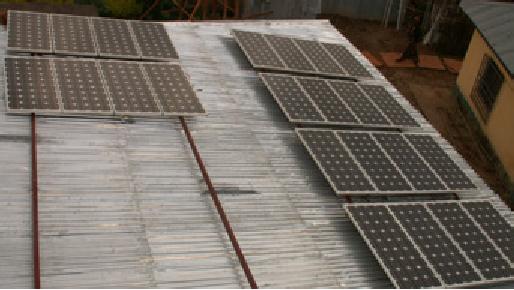
310
Chapter
11: Case Studies
Power
Backup System
In
order to provide a reliable
service to the community,
Zittnet needed to be
equipped
with a stable power backup
system that would make
the network
run
independently of the
NEPA.
A
hybrid power system was
designed for Fantsuam,
consisting of a deep-
cycle
battery bank and 2 kW (peak)
solar panels. The system
can charge
from
three different sources: a
diesel generator, a solar
array, and from
NEPA
when
electricity is available. The
network operation center
(NOC) of the or-
ganization
runs completely from solar
energy. The rest of the
Fantsuam's
premises
runs from NEPA or the
generator via the battery
bank, which pro-
vides
uninterrupted voltage stability.
The NOC load has
been separated from
the
rest of the load of Fantsuam
to ensure a reliable power
source to the
critical
infrastructure in the NOC,
even when the battery
bank is running low
on
power.
Figure
11.1: 24 solar panels with a
nominal power of 80 W have
been mounted to
the
roof
of the NOC to provide power
to the system
24/7.
Simulations
with the best existing
solar data reveal that
Kaduna State, where
Kafanchan
is located, receives at least 4
sun peak hours during
its worst
months
which stretch from June to
August (the rainy
season).
Each
of the solar panels (Suntech
80 W peak) provides a maximum
current
of
5 A (when the solar
radiation is highest during
the day). In the
worst
months
of the year, the system is
expected to produce not less
than 6 KWh/
day.

Chapter
11: Case Studies
311
The
solar system has been
designed to provide 12 and 24 V DC
output in
order
to match the input voltage
of all low power servers
and workstations for
NOC
infrastructure and training
classrooms.
The
solar panels used are
Suntech
STP080S-12/Bb-1 with
the following
specifications:
�
Open-circuit Voltage (VOC): 21.6
V
�
Optimum operating voltage
(VMP): 17.2
V
�
Short-circuit current (ISC): 5
A
�
Optimum operating current
(IMP): 4.65
A
�
Maximum power at STC
(PMAX): 80
W (Peak)
The
minimum 6 KWh/day that feeds
the NOC is used to power
the following
equipment:
Device
Hours/Day
Units
Power
(W)
Wh
Access
points
24
3
15
1080
Low
power servers
24
4
10
960
LCD
screens
2
4
20
160
Laptops
10
2
75
1500
Lamps
8
4
15
480
VSAT
modem
24
1
60
1440
Total
5620
The
power consumption for
servers and LCD screens is
based on Inveneo's
Low
Power Computing Station,
http://www.inveneo.org/?q=Computingstation.
The
total estimated power
consumption of the NOC is
5.6 kWh/day which is
less
than the daily power
generated from the solar
panels in the worst
month.
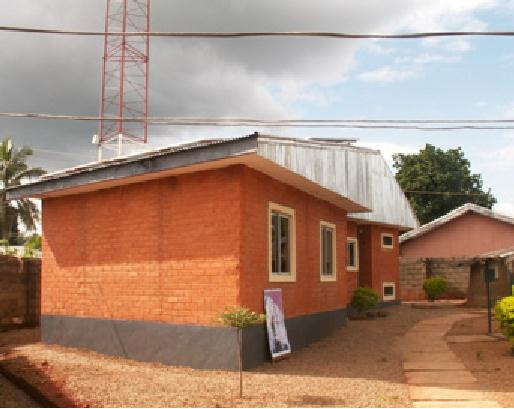
312
Chapter
11: Case Studies
Figure
11.2: The NOC is built by
locally made laterite brick
stones, produced and
laid
by
youths in Kafanchan.
Network
Operating Center (NOC)
A
new Network Operating Center
was established to host the
power backup sys-
tem
and server room facilities. The
NOC was designed to provide a
place safe
from
dust, with good cooling capabilities for
the batteries and the inverters.
The
NOC
uses natural methods and is
made from locally available
materials.
The
building is comprised of four
rooms: a battery storage
room, a server
room,
a working space and a room
for equipment
storage.
The
battery storage room hosts
seventy 200 Ah deep cycle
batteries, as well
as
five inverters
(one of them pure sine
wave), two solar regulators,
power
stabilizers
and DC and AC disconnects.
The batteries are stacked
vertically
on
a metal shelf structure for
better cooling.
The
server space accommodates a
rack unit for servers
and a fan. The
room
has
no regular windows, to avoid
dust and overheating. The
server room and
battery
room face south to improve
natural cooling and to help
keep the room
at
an appropriate temperature.
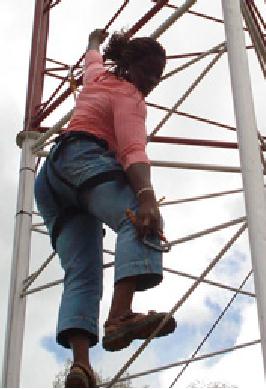
Chapter
11: Case Studies
313
The
server room and the
battery space require
effective low cost/low
energy
cooling
as they need to operate
24x7. To achieve this goal,
natural cooling
techniques
have been introduced in the
NOC design: small fans
and extrac-
tors
and thick walls of bricks
(double width) in the
direction of the
sunset.
The
south side of the building
hosts 24 solar panels in a
shadow-free area on
its
metal roof. The roof
was designed with an
inclination of 20 degrees to
host
the panels and limit
corrosion and dust. Extra
efforts have been made
to
keep
the panels easily reachable
for cleaning and
maintenance. The roof
has
also
been strengthened in order to
carry the extra load of
150-200 kg.
The
NOC building is constructed of
locally produced laterite
mud bricks. The
material
is cheap since it is frequently
used and comes from
the top layer of
soil.
The bricks are produced
locally by hand using a
low-tech pressing
tech-
nique.
The NOC is unique for
its kind in Kaduna
State.
Figure
11.3: Omolayo Samuel, one of
the staff of Zittnet, does
not fear the height
of
the
45m tall tower as she is
aligning the antennas hosted
in the top of the
tower.
Physical
infrastructure: A communication
mast
Most
potential clients to Zittnet are located between 1 km and 10 km
from the
premises
of Fantsuam. In order to reach these clients, Fantsuam established
a
communication
mast on their premises. In October 2006, a
45m (150 foot) tall
self-
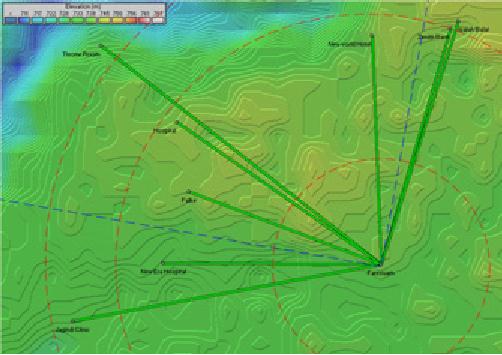
314
Chapter
11: Case Studies
standing
mast was installed at Fantsuam
Foundation. The mast was
equipped
with
grounding and lighting
protection as well as a mandatory
signal light.
A
metal ring was buried at
the base of the tower at a
depth of 4 feet. All
three
legs
of the mast were then
connected to the grounding
circuit. A lightning
rod
was
mounted at the highest point
of the mast to protect the
equipment
against
lighting strikes. The rod is
made of pure copper and is
connected to
the
earth ring at the base of
the mast using copper
tape.
The
signal light mounted at the
top of the mast is a
requirement from the
Civil
Aviation
Authorities. The light is
equipped with a photocell
which enables
automated
switching based on the level
of ambient light. In this
way, the light
comes
on at night and goes off
during the day.
Wireless
backbone infrastructure
The
wireless backbone infrastructure is
built using SmartBridges
multi-band
access
points and client units
from the Nexus PROTM TOTAL
series. The
units
are designed for service
providers and enterprises to
establish high
performance
point-to-multipoint outdoor wireless
links. They come with
an
integrated
multi-band sectoral antenna
that can operate both in
2.4 GHz and
5.1-5.8
GHz frequencies. The Nexus
PROTM TOTAL series offers
QoS for
traffic
prioritization and bandwidth
management per client using
the IEEE
802.11e
compliant WMM (WiFi
Multimedia) extensions.
Figure
11.4: The network topology
of Zittnet in October
2007.
Chapter
11: Case Studies
315
Currently,
the topology of the network
is a star topology with two
access
points
in the communication mast at
Fantsuam's premises. One
access point
hosts
a 90 degree sectoral antenna
(blue dotted lines) and
the other access
point
provides omnidirectional coverage to
the surroundings (red
dotted
rings).
Clients that are located
within the area between
the dotted lines
are
connected
to the sectoral antenna,
while the remaining clients
are connected
to
the omnidirectional
antenna.
Plans
are underway to expand the
wireless backbone by setting up
two wire-
less
repeaters. One repeater will
be located in Kafanchan city
using an exist-
ing
NITEL tower to enhance the
wireless coverage in the
city center. The
second
repeater will be established in
the Kagoro Hills, a small
mountain
group
with a relative altitude to
Kafanchan of about 500m,
which is located
about
7 km from Kafanchan. This
repeater will provide
coverage to many
surrounding
towns and may even
enable a long-distance link to
Abuja.
Zittnet
connected its first
client in early August 2007.
Two months later, no
less
than eight clients are
connected to Zittnet. These
clients include:
�
The general hospital
�
New Era Hospital
�
Jagindi Street Clinic
(health clinic)
�
Zenith Bank (for private
use)
�
Isaiah Balat (Internet
caf�)
�
New World Hotel
�
Throne Room
GuestHouse
�
Fulke
Problems
encountered
A
few problem areas that
have been constantly present
throughout the pro-
ject
are as follows.
Low
buildings
Most
client premises are
single-story buildings with a
height of no more
than
3
meters. Many houses have
very weak roof structures
which makes it im-
possible
to mount equipment on the
roof, as physical access is
not possible.
The
low buildings force us to
mount the equipment at a
fairly low height, as
clients
can not afford to invest in
small (10 m) masts to host
the equipment.
Most
installations make use of
water tanks or a simple 3
meter metal pole
attached
to the wall of the
premise.
316
Chapter
11: Case Studies
When
the equipment is mounted
low, the first Fresnel
zone is not cleared
and
lower
throughput is experienced. Although
the landscape in Kafanchan is
very
flat,
vegetation in the form of
thick mango trees easily
block the
line-of-sight.
Lightning
strikes
Heavy
thunder storms are frequent
during the rainy season in
Kafanchan. In
September
2007, a nearby lightning
strike damaged equipment
mounted on
a
mast, as well as its power
supply. At the moment, the
access point and
its
PoE
injector are grounded to the
tower itself. Further means
need to be in-
vestigated
to prevent damage to equipment
caused by nearby lightning.
The
Zittnet
team is currently working on
improving the surge
protection by adding
extra
coaxial surge arrestors.
Furthermore, the shield of
the UTP cable
con-
necting
the access point with
the NOC will be grounded
using grounding
blocks
and fasteners.
Low
Quality Equipment
Unfortunately,
a lack of quality products on
the market is a widespread
prob-
lem
across the whole African
continent. As most sub-Sahara
countries lack
policies
for quality assurance of
imported goods, the market
is flooded
by
"cheap"
and very low quality
articles. Since quality
products are hard to find,
you
often find yourself
buying locally available
merchandise that breaks
even
before
it is put into operation. As no
sort of warranty exists for
these minor
purchases,
this ends up being very
expensive. This problem is
almost always
present
in common accessories such as
power sockets, power bars,
RJ45
connectors,
CAT5 cabling, and other
low-tech equipment.
Business
Model
The
only alternative for
Internet access in Kafanchan is
via satellite. During
2006,
Fantsuam had a subscription of
128/64 kbps dedicated
bandwidth at a
cost
of $1800 USD/month. This
huge monthly cost of
connectivity has been
a
big
burden for Fantsuam and a
constant stress of being
unable to meet the
monthly
bill.
As
an alternative to the high
risk "flat fee"
model, Fantsuam has
implemented
a
system called HookMeUP
provided by
Koochi Communications. The
sys-
tem
offers flexible
Pay-As-You-Go charges over
broadband VSAT
Internet
connections
to countries across sub-Sahara
Africa.
This
kind of access model is
typically found in airports,
hotels or large shop-
ping
malls in western countries
where end-users buy vouchers
online and log
in
using an access code.

Chapter
11: Case Studies
317
The
HookMeUP system offers a
512/256 kbps
dedicated VSAT connection
to
Fantsuam
(from their ground station
in the UK). Fantsuam buys
vouchers
from
Koochi Communications and
resells them to its local
clients in Kafan-
chan.
In this way, Fantsuam is no
longer stuck with a fixed
monthly cost but
has
only to pay Koochi for
the bandwidth they actually
have consumed. The
risk
of buying expensive international
bandwidth has now been
transferred to
the
Internet provider instead of
the end user, at a cost of a
higher price for
the
end user.
Fantsuam
foundation now acts as a
reseller of vouchers from
Koochi and a
supplier
of wireless infrastructure to the
end users. The Wireless
Community
Network
now provides the Fantsuam
Foundation with five sources of
income:
1.
Installation of client premises
equipment (one occasion per
client)
2.
Leasing of wireless equipment
(monthly cost per
client)
3.
Reselling wireless equipment
(one occasion per
client)
4.
Installation of wireless hotspot at
client's premise (one
occasion per client)
5.
Reselling of vouchers
(continuously)
The
voucher system is based on
three parameters: access
time,
data
limit
and
validity
time. Whichever
parameter runs out first
will consume the
voucher.
Access
Data
limit
Validity
Price
USD
/ h
USD
/
time
(MB)
time
(USD)
700
MB
30
min
5
1
day
0.80
1.60
112.00
60
min
10
5
days
1.28
1.28
89.60
12
hours
60
14
days
10.40
0.87
121.33
24
hours
150
30
days
26.00
1.08
121.33
1
month
500
1
month
71.50
0.10
100.10
3
months
1600
3
months
208.00
0.10
91.00
6
months
3500
6
months
416.00
0.10
83.20
12
months
7500
12
months
728.00
0.08
67.95
318
Chapter
11: Case Studies
The
greatest advantage of this
system is that Fantsuam
Foundation no
longer
has the burden of a huge
monthly bill for
international bandwidth.
Hav-
ing
a flat-fee
model means that you
are forced to sell a certain
amount of
bandwidth
every month. With the
Pay-As-You-Go (PAYG) model,
Fantsuam's
income
from reselling vouchers
depends on how much
bandwidth their cli-
ents
consume. The client pays in
advance (pre-paid model)
with the result
that
Fantsuam will never end up
in huge debt with the
provider.
The
pre-paid model works well in
Africa since people are
familiar with this
model
from mobile operators. It is
even used by electricity
companies in
some
counties. The pre-paid model
is appreciated by many as it helps
them
to
keep track of their
expenditures. One of the
main limitations of the
PAYG
model
is the lack of flexibility
and transparency. The
current PAYG system
provides
very little feedback to the
user about consumed time or
volume.
Only
when the user logs
off will he/she be informed
about how many
minutes
are
left to spend.
However,
the business model seems to
fit the
local reality of Kafanchan
and
many
other rural communities in
Africa quite well. Although
there is room for
improvement,
the advantage of avoiding
debts is far greater than
the disad-
vantages.
With time, when the
number of clients have
increased and they
can
rely on a substantial monthly
income from the wireless
network, it might
be
beneficial to go
back to the flat-fee
model again.
Clients
The
clients are free to use
the Internet access for
any purpose. For
example,
Isaiah
Balat is reselling vouchers
(that he bought from
Fantsuam) to his cli-
ents.
His Internet caf� hosts 10
computers that all are
connected to Zittnet.
The
clients purchase vouchers
from the owner with a
margin of 25% over
the
price
offered by Fantsuam. In return,
clients that do not have
access to a
computer
connected to Zittnet can
access the network though
the PC's at
Isaiah
Balat's caf�.
The
New World Hotel is another
client that aims to create a
similar business
model
but on a larger scale. They
will provide wireless
Internet access to
all
of
their rooms and offer
access to Zittnet's uplink by
reselling vouchers.
Other
clients, like the General
Hospital and the Jagindi
Street Clinic, are
us-
ing
the Internet access for
professional and private use
without reselling ac-
cess
to its clients.
--Louise
Berthilson
Chapter
11: Case Studies
319
Case
study: The quest for
affordable
Internet
in rural Mali
For
several years the
international development community
has promoted
the
idea of closing the digital
divide. This invisible chasm
that has formed
separating
access to the wealth of
information and communications
tech-
nologies
(ICT) between the developed
and the developing world.
Access to
information
and communications tools has
been shown to have a
dramatic
impact
on quality of life. For many
donors fatigued by decades of
supporting
traditional
development activities, the
installation of a telecentre in the
devel-
oping
world seems like a
realizable and worthwhile
effort. Because the
infra-
structure
does not exist, this is
much more expensive and
difficult to do in
the
developing
world than it is in the
West. Moreover, few models
have been
shown
to sustain these activities. To
help mitigate some of the
cost of bring-
ing
the Internet to rural areas
of the developed world, the
author's team has
promoted
the use of wireless systems
to share the cost of an
Internet con-
nection.
In November of 2004, an affiliated
project asked the author's
team to
pilot
such a wireless system at a
recently installed telecentre in
rural Mali, 8
hours
South-West by four-by-four from
Bamako, the capital.
This
rural city, located on the
margin of a man-made reservoir,
holds water
for
the Manitali dam that
powers a third of the
country. This location is
fortu-
nate
as hydroelectric power is much
more stable and available
than diesel
generated
power. While diesel
generated power is far less
stable, some rural
communities
are lucky to have any
electricity at all.
The
city is also endowed to be in
one of the most fertile
regions of the coun-
try,
in its cotton belt, Mali's
main cash crop. It was
believed that this
site
would
be the least difficult of
the rural areas in Mali to
make a self-sustaining
telecentre.
Like many experiments, this
pilot was fraught with
challenges.
Technologically
it was a simple task. In 24
hours the team installed
an
802.11b
wireless network that shares
the telecenter's VSAT
Internet connec-
tion
with 5 other local services:
the Mayor, the Governor,
the health service,
the
district's Mayor's council
(CC) and the community
advisory service
(CCC).
These
clients had been selected
during a reconnaissance two
months prior.
During
that visit the team
had interviewed potential
clients and
determined
which
clients could be connected
without complicated or expensive
installa-
tions.
The telecentre itself is
housed at the community
radio station. Radio
stations
tend to be great sites to
host wireless networks in
rural Mali as they
are
often well placed, have
electricity, security and
people who understand
at
least
the basics of radio
transmissions. They are also
natural hubs for a
vil-
320
Chapter
11: Case Studies
lage.
Providing Internet to a radio
station provides better
information to its
listeners.
And for a culture which is
principally oral, radio
happens to be the
most
effect means to provide
information.
From
the list of clients above,
you will note that
the clients were all
govern-
ment
or para-governmental. This proved to be a
difficult
mix, as there is con-
siderable
animosity and resentment
between the various levels
of govern-
ment,
and there were continuing
disputes regarding taxes and
other fiscal
matters.
Fortunately the director of
the radio station, the
network's champion,
was
very dynamic and was
able to wade through most of
these politics,
though
not all.
Design
choices
The
technical team determined
that the access point
would be installed at 20
meters
up the radio station tower,
just below the FM radio
dipoles, and not so
high
as to interfere with coverage to
client sites below in the
bowl-like de-
pression
where most were found.
The team then focused on
how to connect
each
client site to this site. An
8 dBi omni (from
Hyperlinktech,
http://hyperlinktech.com/) would
suffice,
providing coverage to all
client
sites.
The 8 dBi antenna that
was chosen has a 15 degree
vertical beam-
width,
assuring that the two
clients less than a
kilometer away could still
re-
ceive
a strong signal. Some
antennae have very narrow
beam width and
thus
"overshoot"
sites that are close.
Panel antennae were
considered, though at
least
two would be required and
either a second radio or a
channel splitter. It
was
deemed unnecessary for this
installation. The following
calculation
shows
how to calculate the angle
between the client site's
antenna and the
base
station's antenna, using
standard trigonometry.
tan(x)
=
difference
in elevation
+
height
of base station antenna
-
height
of CPE antenna
/
distance
between the sites
tan(x)
= 5m + 20m - 3m / 400m
x
= tan-1 (22m / 400m)
x
=~ 3 degrees
In
addition to the equipment in
the telecentre (4 computers, a
laser printer, 16
port
switch), the radio station
itself has one Linux
workstation installed by
the
author's
project for audio editing. A
small switch was installed
in the radio
station,
an Ethernet cable was run
through plastic tubing
buried at 5 cm
across
to the telecentre, across
the yard.
From
the main switch, two
cables run up to a Mikrotik
RB220, access point.
The
RB220 has two Ethernet
ports, one that connects to
the VSAT through a
cross-over
cable, and the second
that connects to the radio
station's central
Chapter
11: Case Studies
321
switch.
The RB 220 is housed in a
D-I-Y PVC enclosure and an 8
dBi omni
(Hyperlink
Technologies) is mounted directly to
the top of the PVC
cap.
The
RB220 runs a derivative of
Linux, Mikrotik version
2.8.27. It controls
the
network,
providing DHCP, firewall,
and DNS-caching services,
while routing
traffic
to the VSAT using NAT.
The Mikrotik comes with a
powerful command
line
and a relatively friendly
and comprehensive graphical
interface. It is a
small
x86 based computer, designed
for use as an access point
or embed-
ded
computer. These access
points are POE capable,
have two Ethernet
ports,
a mini-pci port, two PCMCIA
slots, a CF reader (which is
used for its
NVRAM),
are temperature tolerant and
support a variety of x86
operating
systems.
Despite that the Mikrotik
software requires licensing,
there was al-
ready
a substantial user base in
Mali. The system has a
powerful and friendly
graphical
interface that was superior
to other products. Due to
the above fac-
tors
the team agreed to use
these systems, including the
Mikrotik software to
control
these networks. The total
cost of the RB220, with
License Level 5,
Atheros
mini-pci a/b/g and POE
was $461. You can
find these
parts at Mik-
rotik
online at http://www.mikrotik.com/routers.php#linx1part0.
The
network was designed to
accommodate expansion by segregating
the
various
sub-networks of each client; 24
bit private subnets were
alloted. The
AP
has a virtual interface on
each subnet and does
all routing between,
also
allowing
fire-walling at
the IP layer. Note: this
does not provide a firewall
at
the
network layer, thus, using a
network sniffer like tcpdump
one can see
all
traffic
on the wireless link.
To
limit access to subscribers,
the network uses MAC
level access control.
There
was little perceived
security risk to the
network. For this first
phase, a
more
thorough security system was
left to be implemented in the
future, when
time
could be found to find an
easier interface for
controlling access.
Users
were
encouraged to use secure
protocols, such as https,
pops, imaps etc.
The
affiliate
project had installed a
C-band VSAT (DVB-S) system.
These
satellite
systems are normally very
reliable and are often
used by ISPs. It is a
large
unit, in this case the
dish was 2.2 meters in
diameter and
expensive,
costing
approximately $12,000 including
installation. It is also expensive
to
operate.
A 128 kbps down and 64
kbps up Internet connection
costs ap-
proximately
$700 per month. This
system has several
advantages compared
to
a Ku system though, including:
greater resilience to bad
weather, lower
contention
rates (number of competing
users on the same service)
and it is
more
efficient
at transferring data.
The
installation of this VSAT
was not ideal. Since
the system ran
Windows,
users
were able to quickly change
a few settings, including
adding a pass-
word
to the default account. The
system had no UPS or battery
back up, so
once
a power outage occurred the
system would reboot and
sit waiting for a
322
Chapter
11: Case Studies
password,
which had since been
forgotten. To make this
situation worse,
because
the VSAT software was
not configured as an
automatic background
service
it did not automatically
launch and establish the
link. Though the C-
band
systems are typically
reliable, this installation
caused needless
outages
which
could have been resolved
with the use of a UPS,
proper configuration
of
the VSAT software as a
service, and by limiting
physical access to
the
modem.
Like all owners of new
equipment, the radio station
wanted to dis-
play
it, hence it was not
hidden from view. Preferably
a space with glass
doors
would have kept the
unit secure while keeping it
visible.
The
wireless system was fairly
simple. All of the client
sites selected were
within
2 km of the radio station.
Each site had a part of
the building that
could
physically
see the radio station. At
the client site, the
team chose to use
commercial,
client grade CPEs: Based on
price, the Powernoc 802.11b
CPE
bridge,
small SuperPass 7 dBi patch
antennas and home-made Power
Over
Ethernet
(POE) adaptors. To facilitate
installation, the CPE and
the patch
antenna
were mounted on a small
piece of wood that could be
installed on
the
outside wall of the building
facing the radio
station.
In
some cases the piece of
wood was an angled block to
optimize the posi-
tion
of the antenna. Inside, a
POE made from a repurposed
television signal
amplifier
(12V) was used to power
the units. At the client
sites there were
not
local
networks, so the team also
had to install cable and
hubs to provide
Internet
for each computer. In some
cases it was necessary to
install Ether-
net
adapters and their drivers
(this was not determined
during the assess-
ment).
It was decided that because
the client's networks were
simple, that it
would
be easiest to bridge their
networks. Should it be required,
the IP archi-
tecture
could allow future
partitioning and the CPE
equipment supported
STA
mode.
We used a PowerNOC CPE
bridge that cost
$249.
Local
staff were involved during
the installation of the
wireless network.
They
learned everything from
wiring to antenna placement. An
intensive
training
program followed the
installation. It lasted several
weeks, and was
meant
to teach the staff the
day to day tasks, as well as
basic network
troubleshooting.
A
young university graduate
who had returned to the
community was chosen
to
support the system, except
for the cable installation,
which the radio
sta-
tion
technician quickly learned.
Wiring Ethernet networks is
very similar to
coaxial
cable repairs and
installations which the
radio technician already
per-
formed
regularly. The young
graduate also required
little training. The
team
spent
most of its time helping
him learn how to support
the basics of the
sys-
tem
and the telecentre. Soon
after the telecentre opened,
students were
lined
up for the computer
training, which offered 20
hours of training and
Internet
use per month for
only $40, a bargain compared
to the $2 an hour
Chapter
11: Case Studies
323
for
Internet access. Providing
this training was a
significant
revenue and was
a
task that the young
computer savvy graduate was
well suited for.
Unfortunately,
and somewhat unsurprisingly,
the young graduate left
for the
capital,
Bamako, after receiving an
offer for a government job.
This left the
telecentre
effectively marooned. Their
most technically savvy
member, and
the
only one who was
trained in how to support
the system, had left.
Most of
the
knowledge needed to operate
the telecentre and network
left with him.
After
much deliberation, the team
determined that it was best
not to train an-
other
tech savvy youth, but
rather to focus on the
permanent local staff,
de-
spite
their limited technical
experience. This took much
more time. Our
train-
ers
have had to return for a
total of 150 hours of
training. Several
people
were
taught each function, and
the telecentre support tasks
were divided
among
the staff.
Training
did not stop there.
Once the community services
were connected,
they
too needed access. It seemed
that although they were
participating,
the
principals, including the
mayor, were not using
the systems
themselves.
The
team realized the importance
of assuring that the
decision makers
used
the system, and provided
training for them and
their staff. This
did
remove
some of the mystique of the
network and got the
city's decision
makers
involved.
Following
training, the program
monitored the site and
began to provide in-
put,
evaluating ways that this
model could be improved.
Lessons learned
here
were applied to other
sites.
Financial
Model
The
community telecentre was
already established as a
non-profit, and
was
mandated
to be self-sustaining through the
sale of its services. The
wireless
system
was included as a supplementary
source of revenue because
early
financial
projections for the
telecentre indicated that
they would fall short
of
paying
for the VSAT
connection.
Based
on the survey, and in
consultation with the radio
station that manages
the
telecentre, several clients
were selected. The radio
station negotiated
contracts
with some support from
its funding partner. For
this first
phase, cli-
ents
were selected based on ease
of installation and expressed
ability to pay.
Clients
were asked to pay a
subscription fee, as described
later.
Deciding
how much to charge was a
major activity which
required consultation
and
expertise that the community
did not have in financial
projections. The
equipment
was paid for by the
grant, to help offset the
costs to the
community,
but
clients were still required
to pay a subscription fee,
which served to as-
sure
their commitment. This was
equivalent to one month of
the service fee.
324
Chapter
11: Case Studies
To
determine the monthly cost
for an equal slice of
bandwidth we started
with
the
following formula:
VSAT
+ salaries + expenses (electricity, supplies) =
telecentre
revenue + wireless client revenue
We
had estimated that the
telecentre should earn about
$200 to $300 per
month
in revenue. Total expenses
were estimated to be $1050
per month,
and
were broken down as:
$700 for the VSAT,
$100 for salaries, $150
for
electricity,
and about $100 for
supplies. About $750 in
revenue from the
wire-
less
clients was required to
balance this equation. This
amounted to roughly
$150
from each client. This
was just tolerable by the
clients, and looked
fea-
sible,
but required fair weather,
and had no room for
complications.
Because
this was becoming
complicated, we brought in business
geeks, who
modified
the formula as such:
Monthly
expenses + amortization + safety funds = total
revenue
The
business experts were quick
to point out the need of
amortization of the
equipment,
or one could say
"re-investment funds" as well as
safety funds, to
assure
that the network can
continue if a client defaults, or if
some equip-
ment
breaks. This added about
$150 per month for
amortization (equipment
valued
at about $3,000, amortized
over 24 months) and the
value of one cli-
ent
for default payments, at
$100. Add another 10% to
account for currency
devaluation
($80), and that equals an
expense of $1380 per month.
In trying
to
implement this model, it was
finally
determined that amortization is a
con-
cept
that was too difficult
to convey to the community,
and that they
would
not
consider that clients might
default on payment. Thus,
both formulae were
used,
the first by
the telecentre and the
second for our internal
analysis.
As
was soon discovered, regular
payments are not part of
the culture in rural
Mali.
In an agrarian society everything is
seasonal, and so too is
income.
This
means that the community's
income fluctuates
wildly. Moreover, as
many
public institutions were
involved, they had long
budget cycles with
little
flexibility.
Although they theoretically
had the budget to pay
for their service, it
would
take many months for
the payments to be made.
Other fiscal
compli-
cations
arose as well. For example,
the mayor signed on and
used the back-
taxes
owed by the radio to pay
for its subscription. This
of course did not
contribute
to cash flow.
Unfortunately, the VSAT
providers have little flexibil-
ity
or patience, as they have
limited bandwidth and only
have room for
those
that
can pay.
Cash
flow management
became a primary concern.
First, the revenue
fore-
seen
in financial
projections showed that even
with an optimistic
outlook,
they
would not only have
trouble earning enough
revenue on time to pay
the
Chapter
11: Case Studies
325
fee,
but getting the money to
the Bamako-based bank also
presented a prob-
lem.
Roads near the village
can be dangerous, due to the
number of smug-
glers
from Guinea and wayward
rebels from the Ivory
Coast. As projected,
the
telecentre was not able to
pay for its service
and its service was
sus-
pended,
thereby suspending payment
from their clients as
well.
Before
the project was able to
find solutions
to these problems, the cost
of
the
VSAT already began to dig
the telecentre into debt.
After several months,
due
to technical problems, as well as
concerns raised in this
analysis, the
large
C-band VSAT was replaced
with a cheaper Ku band
system. Although
cheaper,
it still sufficed
for the size of the
network. This system was
only
$450,
which by ignoring amortization
and safety margins is
affordable by the
network.
Unfortunately, due to default
payments, the network was
not able to
pay
for the VSAT connection
after the initial subsidized
period.
Conclusions
Building
a wireless network is relatively
easy, but making it work is
much
more
of a business problem than a
technical problem. A payment
model that
considers
re-investment and risk is a
necessity, or eventually the
network will
fail.
In this case, the payment
model was not appropriate as
it did not con-
form
to fiscal
cycles of the clients, nor
did it conform to social
expectations. A
proper
risk analysis would have
concluded that a $700 (or
even a $450)
monthly
payment left too narrow a
margin between revenue and
expenses to
compensate
for fiscal
shortcomings. High demand
and education needs
lim-
ited
the expansion of the
network.
Following
training the network
operated for 8 months
without significant techni-
cal
problems. Then, a major
power surge caused by a
lightning strike de-
stroyed
much of the equipment at the
station, including the
access point and
VSAT.
As a result, the telecentre
was still off-line at the
time that this book
was
written.
By that time this formula
was finally deemed an
unsuitable solution.
Ian
Howard
Case
study: Commercial deployments
in
East
Africa
Describing
commercial wireless deployments in
Tanzania and Kenya,
this
chapter
highlights technical solutions
providing solid, 99.5%
availability Inter-
net
and data connectivity in
developing countries. In contrast to
projects de-
voted
to ubiquitous access, we focused on
delivering services to
organiza-
tions,
typically those with
critical international communications
needs. I will
326
Chapter
11: Case Studies
describe
two radically different
commercial approaches to wireless
data con-
nectivity,
summarizing key lessons
learned over ten years in
East Africa.
Tanzania
In
1995, with Bill Sangiwa, I
founded CyberTwiga, one of
the first
ISPs in Af-
rica.
Commercial services, limited to
dialup email traffic carried
over a
9.6
kbps
SITA link (costing over
$4000/month!), began in mid-1996.
Frus-
trated
by erratic PSTN services,
and buoyed by a successful
deployment of a
3-node
point-multipoint (PMP) network
for the Tanzania Harbours
authority,
we
negotiated with a local
cellular company to place a
PMP base station on
their
central mast. Connecting a
handful of corporations to this
WiLan pro-
prietary
2.4 GHz system in late
1998, we validated the
market and our
tech-
nical
capacity to provide wireless
services.
As
competitors haphazardly deployed
2.4 GHz networks, two
facts emerged:
a
healthy market for wireless
services existed, but a
rising RF noise floor
in
2.4
GHz would diminish network
quality. Our merger with
the cellular carrier,
in
mid-2000, included plans for
a nationwide wireless network
built on the
existing
cellular infrastructure (towers
and transmission links) and
proprietary
RF
spectrum allocations.
Infrastructure
was in place (cellular
towers, transmission links,
etc.) so wire-
less
data network design and
deployment were straightforward.
Dar es Sa-
laam
is very flat,
and because the cellular
partner operated an analog
net-
work,
towers were very tall. A
sister company in the UK,
Tele2, had com-
menced
operations with Breezecom
(now Alvarion) equipment
in
3.8/3.9
GHz, so we
followed their lead.
By
late 2000, we had
established coverage in several
cities, using
fractional
E1
transmission circuits for
backhaul. In most cases the
small size of the
cities
connected justified the
use of a single omnidirectional
PMP base sta-
tion;
only in the commercial
capital, Dar es Salaam, were
3-sector base sta-
tions
installed. Bandwidth limits
were configured
directly on the
customer
radio;
clients were normally issued
a single public IP address.
Leaf routers
at
each base station sent
traffic to static IP
addresses at client locations,
and
prevented
broadcast traffic from
suffocating the network.
Market pressures
kept
prices down to about
$100/month for 64 kbps, but
at that time
(mid/late
2000)
ISPs could operate with
impressive, very profitable,
contention ratios.
Hungry
applications such as peer-peer
file sharing,
voice, and ERPs
simply
did
not exist in East Africa.
With grossly high PSTN
international charges,
organizations
rapidly shifted from fax to
email traffic, even
though their wire-
less
equipment purchase costs
ranged from
$2000-3000.
Technical
capabilities were developed
in-house, requiring staff
training over-
seas
in subjects such as SNMP and
UNIX. Beyond enhancing the
company
Chapter
11: Case Studies
327
skills
set, these training
opportunities generated staff
loyalty. We had to
com-
pete
in a very limited IT labor
market with international
gold mining compa-
nies,
the UN, and other
international agencies.
To
insure quality at customer
sites, a top local radio
and telecoms
contractor
executed
installations, tightly tracking
progress with job cards.
High tempera-
tures,
harsh equatorial sunlight,
drenching rain, and
lightning were among
the
environmental insults tossed at
outside plant components; RF
cabling
integrity
was vital.
Customers
often lacked competent IT
staff, burdening our
employees with
the
task of configuring
many species of network
hardware and
topology.
Infrastructure
and regulatory obstacles
often impeded operations.
The cellu-
lar
company tightly controlled
towers, so that if there was
a technical issue at
a
base station hours or days
could pass before we gained
access. Despite
backup
generators and UPS systems
at every site, electrical
power was al-
ways
problematic. For the
cellular company, electrical
mains supplies at
base
stations were less critical.
Cellular subscribers simply
associated with a
different
base station; our fixed
wireless data subscribers
went offline.
On
the regulatory side, a major
disruption occurred when the
telecoms
authority
decided that our operation
was responsible for
disrupting C-band
satellite
operations for the entire
country and ordered us to
shut down our
network.
Despite
hard data demonstrating that
we were not at fault, the
regulator con-
ducted
a highly publicized seizure of
our equipment. Of course the
interfer-
ence
persisted, and later was
determined to emanate from a
Russian radar
ship,
involved in tracking space
activities. We quietly negotiated
with the
regulator,
and ultimately were rewarded
with 2 x 42 MHz of proprietary
spec-
trum
in the 3.4/3.5 GHz bands.
Customers were switched over
to dialup in
the
month or so it took to reconfigure
base stations and install
new CPE.
Ultimately
the network grew to about
100 nodes providing good,
although not
great,
connectivity to 7 cities over
3000+km of transmission links.
Only the
merger
with the cellular operator
made this network
feasible--the scale of
the
Internet/data business alone
would not have
justified building a
data net-
work
of these dimensions and
making the investments
needed for
proprietary
frequencies.
Unfortunately, the cellular
operator took the decision
to close
the
Internet business in
mid-2002.
Nairobi
In
early 2003 I was approached
by a Kenyan company, AccessKenya,
with
strong
UK business and technical
backup to design and deploy
a wireless
328
Chapter
11: Case Studies
network
in Nairobi and environs.
Benefiting
from superb networking
and
business
professionals, improved wireless
hardware, progress in
internet-
working,
and bigger market we
designed a high availability
network in line
with
regulatory constraints.
Two
regulatory factors drove our
network design. At the time
in Kenya, Inter-
net
services were licensed
separately from public data
network operators,
and
a single company could not
hold both licenses. Carrying
traffic of
multi-
ple,
competing ISPs or corporate
users, the network had to
operate with total
neutrality.
Also, "proprietary" frequencies,
namely 3.4/3.5 GHz, were
not ex-
clusively
licensed to a single provider,
and we were concerned about
inter-
ference
and the technical
ability/political will of the
regulator to enforce.
Also,
spectrum
in 3.4/3.5 GHz was
expensive, costing about
USD1000 per MHz
per
year per base station.
Restated, a base station
using 2 x 12 MHz at-
tracted
license fees of over $10,000
year. Since Nairobi is a
hilly place with
lots
of tall trees and valleys,
wireless broadband networks
demanded many
base
stations. The licensing
overheads simply were not
sensible. In con-
trast,
5.7/5.8 GHz frequencies were
subject only to an annual
fee, about USD
120,
per deployed radio.
To
meet the first
regulatory requirement we chose to
provide services
using
point-point
VPN tunnels, not via a
network of static IP routes. An
ISP would
deliver
a public IP address to our
network at their NOC. Our
network con-
ducted
a public-private IP conversion, and
traffic transited
our network in pri-
vate
IP space. At the customer
site, a private-public IP conversion
delivered
the
globally routable address
(or range) to the customer
network.
Security
and encryption added to
network neutrality, and flexibility,
as unique
sales
properties of our network.
Bandwidth was limited at the
VPN tunnel
level.
Based on the operating
experience of our sister UK
company, Virtu-
alIT,
we selected Netscreen (now
subsumed under Juniper
Networks) as the
vendor
for VPN firewall
routers.
Our
criteria for wireless
broadband equipment eliminated
big pipes and
feature-rich,
high performance gear. Form
factor, reliability, and
ease of in-
stallation
and management were more
important than throughput.
All inter-
national
Internet connections to Kenya in
2003, and at this writing,
are car-
ried
by satellite. With costs
100X greater than global
fiber,
satellite connec-
tivity
put a financial
ceiling on the amount of
bandwidth purchased by
end-
users.
We judged that the bulk of
our user population required
capacity on
the
order of 128 to 256 kbps. We
selected Motorola s
recently
introduced
Canopy
platform in line with our
business and network
model.
Broadband
Access, Ltd., went live in
July 2003, launching the
"Blue" network.
We
started small, with a single
base station. We wanted
demand to drive our
Chapter
11: Case Studies
329
network
expansion, rather than
relying on a strategy of building
big pipes and
hoping
we could fill
them.
Canopy,
and third-party enhancements
such as omnidirectional base
sta-
tions,
permitted us to grow our
network as traffic grew,
softening initial
capi-
tal
expenditures. We knew the
tradeoff was that as the
network expanded,
we
would have to sectorize
traffic and
realign client radios. The
gentle learn-
ing
curve of a small network
paid big dividends later.
Technical staff
became
comfortable
with customer support issues
in a simple network
environment,
rather
than have to deal with
them on top of a complex RF
and logical
framework.
Technical staff attended
two-day Motorola training
sessions.
A
typical PMP design, with
base stations linked to a
central facility via a
Can-
opy
high-speed microwave backbone,
the network was deployed on
building
rooftops,
not antenna towers.
All leases stipulated
24x7 access for
staff,
mains
power and, critically,
protected the exclusivity of
our radio
frequencies.
We
did not want to restrict
landlords from offering roof
space to competitors,
rather
to simply guarantee that our
own services would not be
interrupted.
Rooftop
deployments provided many
advantages. Unlimited physical
ac-
cess,
unconstrained by night or rain,
helped meet the goal of
99.5% network
availability.
Big buildings also housed
many big clients, and it
was possible
to
connect them directly into
our core microwave network.
Rooftop sites did
have
the downside of more human
traffic--workers
maintaining equipment
(a/c)
or patching leaks would
occasionally damage cabling. As a
result all
base
stations were set up with
two sets of cabling for
all network elements,
a
primary
and a spare.
Site
surveys confirmed
radio path availability and
client requirements.
Sur-
vey
staff logged GPS positions
for each client, and
carried a laser
range-
finder to
determine height of obstacles.
Following receipt of payment
for
hardware,
contractors under the
supervision of a technical staffer
performed
installations.
Canopy has the advantage
that the CPE and
base station ele-
ments
are light, so that most
installations do not need
extensive civil works
or
guying.
Cabling Canopy units was
also simple, with outdoor
UTP connecting
radios
directly to customer networks.
Proper planning enabled
completion of
many
installations in less than an
hour, and contractor crews
did not need
any
advanced training or
tools.
As
we compiled hundreds of customer
GPS positions we began to
work
closely
with a local survey company
to overlay these sites on
topographical
maps.
These became a key planning
tool for base station
placement.
Note
that the point-point VPN
tunnel architecture, with
its separate physical
and
logical layers, required
clients to purchase both
wireless broadband
and
VPN
hardware. In order to tightly
control quality, we categorically
refused to
330
Chapter
11: Case Studies
permit
clients to supply their own
hardware--they had to buy
from us in order
to
have service and hardware
guarantees. Every client had
the same hard-
ware
package. Typical installations
cost on the order of USD
2500, but that
compares
to the $500-600 monthly
charges for 64 to 128 kbps
of bandwidth.
A
benefit of the
VPN tunnel approach was
that we could prevent a
client s
traffic
from passing over the
logical network (i.e. if
their network was hit by
a
worm
or if they didn t
pay a
bill) while the radio
layer remained intact
and
manageable.
As
it grew from one base
station to ten, and service
was expanded to Mom-
basa,
the network RF design
evolved and wherever
possible network ele-
ments
(routers) were configured
with fallover or hot swap
redundancy. Major
investments
in inverters and dual
conversion UPS equipment at
each base
station
were required to keep the
network stable in the face
of an erratic
power
grid. After a number of
customer issues (dropped VPN
connections)
were
ascribed to power blackouts, we
simply included a small UPS
as part of
the
equipment package.
Adding
a portable spectrum analyzer to
our initial capital
investment was
costly,
but hugely justified as we
operated the network.
Tracing rogue opera-
tors,
confirming
the operating characteristics of
equipment, and verifying
RF
coverage
enhanced our
performance.
Fanatical
attention to monitoring permitted us to
uptweak network
perform-
ance,
and gather valuable
historical data. Graphed via
MRTG or Cacti (as
described
in chapter six), parameters
such as jitter, RSSI, and
traffic
warned
of
rogue operators, potential
deterioration of cable/connectors, and
presence
of
worms in client networks. It
was not uncommon for
clients to claim that
service
to their site had been
interrupted for hours/days
and demand a credit.
Historical
monitoring verified or
invalidated these
claims.
The
Blue network combined a
number of lessons from
Tanzania with im-
proved
RF and networking
technologies.
Lessons
learned
For
the next few years
satellite circuits will
provide all international
Internet
connectivity
in East Africa. Several
groups have floated
proposals for sub-
marine
fiber
connectivity, which will
energize telecommunications when
it
happens.
Compared to regions with
fiber
connectivity, bandwidth costs
in
East
Africa will remain very
high.
Wireless
broadband networks for
delivery of Internet services
therefore do
not
need to focus on throughput.
Instead, emphasis should be
placed on
reliability,
redundancy, and flexibility.
Chapter
11: Case Studies
331
Reliability
for our wireless networks
was our key selling
point. On the net-
work
side this translated into
sizable investments in infrastructure
substitu-
tion,
such as backup power, and
attention to details such as
crimping and
cabling.
The most ordinary reasons
for a single customer to
lose connectivity
were
cabling or crimping issues.
Radio failures were
essentially unheard
of.
A
key competitive advantage of
our customer installation
process is that we
pushed
contractors to adhere to tight
specifications. It
was common for
well-
managed
customer sites to remain
connected for hundreds of
days with zero
unscheduled
downtime. We controlled as much of
our infrastructure as
pos-
sible
(i.e building
rooftops).
As
attractive as potential alliances with cellular
providers seem, in our experi-
ence
they raise more problems
than they solve. In East
Africa, Internet busi-
nesses
generate a fraction of the revenue of mobile
telephony, and so are mar-
ginal
to the cellular companies. Trying to
run a network on top of
infrastructure
that
doesn t
belong to
you and is, from
the point of view of the
cellular provider,
a
goodwill gesture, will make
it impossible to meet service
commitments.
Implementing
fully redundant networks,
with fail-over or hotswap
capability is
an
expensive proposition in Africa.
Nonetheless the core routers
and VPN
hardware
at our central point of
presence were fully
redundant, configured
for
seamless
fail-over, and routinely
tested. For base stations we
took the deci-
sion
not to install dual routers,
but kept spare routers in
stock. We judged
that
the 2-3 hours of downtime in
the worst case (failure at
1AM Sunday
morning
in the rain) would be
acceptable to clients. Similarly
weekend staff
members
had access to an emergency
cupboard containing spare
customer
premises
equipment, such as radios
and power supplies.
Flexibility
was engineered into both
the logical and RF designs
of the net-
work.
The point-to-point VPN
tunnel architecture rolled
out in Nairobi was
extraordinarily
flexible in
service of client or network
needs. Client connec-
tions
could be set to burst during
off-peak hours to enable
offsite backup, as
a
single example. We could
also sell multiple links to
separate destinations,
increasing
the return on our network
investments while opening up
new serv-
ices
(such remote monitoring of
CCTV cameras) to
clients.
On
the RF side we had enough
spectrum to plan for
expansion, as well as
cook
up an alternative radio network
design in case of interference.
With the
growing
number of base stations,
probably 80% of our customer
sites had
two
possible base station radios
in sight so that if a base
station were de-
stroyed
we could restore service
rapidly.
Separating
the logical and RF layers of
the Blue network introduced
an addi-
tional
level of complexity and
cost. Consider the long-term
reality that radio
technologies
will advance more rapidly
than internetworking
techniques.
Separating
the networks, in theory,
gives us the flexibility to
replace the exist-
332
Chapter
11: Case Studies
ing
RF network without upsetting
the logical network. Or we
may install a
different
radio network in line with
evolving technologies (Wimax) or
client
needs,
while maintaining the
logical network.
Finally,
one must surrender to the
obvious point that the
exquisite networks
we
deployed would be utterly
useless without unrelenting
commitment to
customer
service. That is, after
all, what we got paid
for.
More
information
�
Broadband Access, Ltd.:
http://www.blue.co.ke/
�
AccessKenya, Ltd.: http://www.accesskenya.com/
�
VirtualIT: http://www.virtualit.biz/
--Adam
Messer, Ph.D
Case
study: Dharamsala Community
Wireless
Mesh Network
The
Dharamsala Wireless-Mesh Community
Network came to life in
Febru-
ary
2005, following the
deregulation of WiFi for
outdoor use in India. By
the
end
of February 2005, the mesh
had already connected 8
campuses.
Extensive
testing during February of
2005 showed that the
hard mountainous
terrain
is most suitable for mesh
networking, as conventional
point-to-
multipoint
networks, cannot overcome
the line-of-sight limitations
presented
by
the mountains. mesh topology
also offered much larger
area coverage,
while
the "self healing" nature of
mesh routing, proved to be
essential in
places
where electricity supply is
very erratic at best.
The
mesh backbone includes over
30 nodes, all sharing a single radio
channel.
Broadband
Internet services are provided to all
mesh members. The total
up-
stream
Internet bandwidth available is 6
Mbps. There are over 2,000
computers
connected
to the mesh, The broadband internet
connection is putting the
mesh
under
great load. At present, the system seems
to handle the load without
any
increase
in latency or packet-loss. It is clear that
scalability will become an
issue
if
we continue to use a single radio channel. To
solve this problem, new
mesh
routers
with multiple radio channel support are
being developed and tested
in
Dharamsala,
with an emphasis on products that meet
our technical require-
ments
and our economically viable.
The initial results are
very promising.
The
mesh network is based on
recurring deployments of a hardware
device,
which
is designed and built
locally known as the
Himalayan-Mesh-Router

Chapter
11: Case Studies
333
(http://drupal.airjaldi.com/node/9). The
same mesh-routers are
installed at
every
location, with only
different antennas, depending on
the geographical
locations
and needs. We use a wide
range of antennas, from 8 - 11
dBi om-
nidirectional,
to 12 - 24 dBi directional antennas
and occasionally some
high-
gain
(and cost) sector
antennas.
The
mesh is primarily used
for:
�
Internet access
�
File-sharing applications
�
Off-site backups
�
Playback of high quality
video from remote
archives.
A
central VoIP, software-based
PBX is installed (Asterisk)
and it provides ad-
vanced
telephony services to members.
The Asterisk PBX is also
interfacing
the
PSTN telephone network.
However, due to legal issues
it is presently
used
only for incoming calls
into the mesh. Subscribers
use a large variety
of
software-phones,
as well as numerous ATAs
(Analog Telephone
Adaptors)
and
full-featured IP phones.
Figure
11.5: Dharamsala installer
working on a tower
The
encrypted mesh back-bone
does not allow access to
roaming mobile
devices
(notebooks and PDAs), so we
have placed multiple 802.11b
access-
points
at many of the same
locations where mesh-routers
are installed. The
mesh
provides the backbone
infrastructure while these
APs provide access
to
mobile roaming devices,
where needed.
Access
to the mesh back-bone is
only possible by mesh-routers.
Simple
wireless
clients lack the
intelligence needed to "speak"
the mesh routing
pro-
tocols
and strict access policies.
The mesh channel is
therefore encrypted
(WPA),
and also "hidden" to prevent
mobile devices from finding it or
attempt-
ing
to access it. Allowing
access to the mesh only by
mesh-routers allows
for
strict
access control policies and
limitations to be enforced at the
CPE (Client
Premises
Equipment) which is a crucial
element needed to achieve
end-to-
end
security, traffic-shaping,
and quality-of-service.
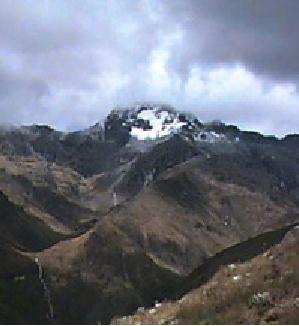
334
Chapter
11: Case Studies
Power
consumption of the mesh-Router is
less than 4 Watts. This
makes
them
ideal for using with
solar panels. Many of the
Dharamsala Mesh
routers
are
powered solely by small
solar panels. The use of
solar power in
combina-
tion
with small antennas and
low power routers is ideally
suitable for disaster
areas,
as it very likely to survive
when all other communication
infrastructure
is
damaged.
--AirJaldi,
http://airjaldi.com/
Case
study: Networking M�rida State
The
city of M�rida lies at the
foot of the highest mountain
in Venezuela, on
a
plateau at about 1600 m. It is
the capital of the state of
M�rida, and home
to
a two- centuries-old university,
with some 35,000 students.
The Univer-
sity
of Los Andes (ULA) deployed
the first academic computer
network in
1989
which, despite economic
limitations, has grown to
encompass 26 km
of
fiber optic cable over
which both a TDM and an
ATM (asynchronous
transfer
mode) network are overlaid.
In 2006, over the same
fiber optic
cable,
a 50 km Gigabit Ethernet network
has been deployed.
Figure
11.6: M�rida is one of the
three mountainous states of
Venezuela, where
the
Andes
reach 5000 m.
Nevertheless,
many places in the city
and the surrounding villages
are out of
reach
of the fiber
optic ring. The university
operates a communication
server
with
telephone lines to provide
remote access to its
network, but local
calls
are
charged by the minute and
many villages lack phone
lines altogether.
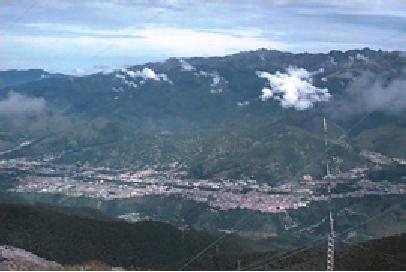
Chapter
11: Case Studies
335
For
these reasons, efforts to
develop wireless access to
the university's
network,
called RedULA, were
undertaken from the very
beginning. The
first
attempts took advantage of
the existing packet network
operated by
radio
amateurs. As early as 1987,
amateurs had a gateway with
an HF
(High
Frequency) station
working at 300 bps for
contacts overseas, as
well
as several VHF
(Very
High Frequency) stations
linked at 1200 bps
that
crisscrossed the
country.
While
the rugged mountains of the
region are a big obstacle
for laying cables
and
building roads, they can be
helpful in deploying a radio
network. This
task
is aided by the existence of a
cable car system, reputedly
the highest in
the
world, which links the
city to a 4765 m
peak.
Figure
11.7: On its way to the
peak, the cable car
passes by an intermediate
station
called
La Aguada, which is 3450 m
high and has an astounding
view of the city
of
M�rida
and other villages at
distances up to 50 km.
Packet
radio
Local
amateurs operate a packet
radio network. Initially it
worked at 1200
bps,
using VHF amateur FM voice
radios connected to a personal
computer
by
means of a terminal
node controller (TNC). The
TNC is the interface
between
the analog radio and
the digital signals handled
by the PC.
The
TNC keys the Push To
Talk circuits in the radio
to change from
transmit
to
receive, performs modulation/demodulation
and the
assembly/disassembly
of
packets using a variation of
the X.25 protocol known as
AX.25.
Gateways
between
VHF and HF radios were
built by attaching two
modems to the
same
TNC and computer. Typically,
a gateway would connect the
local VHF
packet
network to stations overseas by
means of HF stations that
could span
thousands
of kilometers, albeit at a speed of
only 300 bps. A national
packet
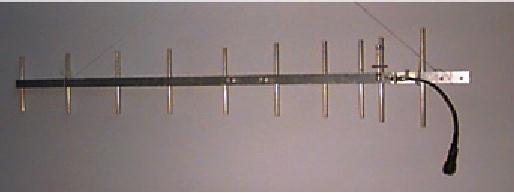
336
Chapter
11: Case Studies
radio
network was also built,
which relayed on digipeaters
(digital
repeaters,
essentially
a TNC connected to two
radios with antennas
pointing in different
directions),
to extend the network from
M�rida to Caracas by means of
just
two
such repeater stations. The
digipeaters operated at 1200
bps and al-
lowed
for the sharing of programs
and some text files
among amateurs.
Phil
Karn, a radio amateur with a
strong background in computer
networks,
wrote
the KA9Q program that
implements TCP/IP over
AX.25. Using this
program,
named after the call
sign of its developer,
amateurs all over
the
world
were soon able to connect to
the Internet using different
kinds of ra-
dios.
KA9Q keeps the functions of
the TNC to a bare minimum,
harnessing
the
power of the attached PC for
most processing functions.
This approach
allows
for much greater flexibility
and easy upgrades. In
M�rida, we were
soon
able to upgrade our network
to 9600 bps by use of more
advanced mo-
dems,
and several radio amateurs
were now able to access
the Internet
through
the RedULA wired network.
The limit on the radio
bandwidth avail-
able
on the VHF band puts a
cap on the highest
attainable speed. To
in-
crease
that speed, one must
move to higher frequency
carriers.
Amateurs
are allowed to use 100
kHz wide channels using
UHF
(Ultra-High
Frequency) signals.
Digital radios coupled with
19.2 kbps modems
doubled
the
transmission bandwidth. A project
was developed using this
technology to
link
the House of Science in the
city of El Vigia, to M�rida
and the Internet.
UHF
antennas were built at
LabCom, the communications
laboratory of ULA.
Figure
11.8: A UHF antenna for
packet radio developed at
ULA, LabCom.
Although
El Vigia is only 100 km from
M�rida by road, the
mountainous ter-
rain
called for the use of
two repeaters. One is
located at La Aguada, at
3600
m
altitude, and the other at
Tusta, at 2000 m. The
project was financed
by
FUNDACITE
MERIDA, a government institution
that promotes science
and
technology
in the state. FUNDACITE also
operates a pool of 56 kbps
tele-
phone
modems to provide Internet
access for institutions and
individuals.
The
need for two repeater
stations underscores the
limitations imposed by
using
higher frequency carriers,
which require line of sight
to establish a reli-
Chapter
11: Case Studies
337
able
transmission. In the much
lower VHF band, signals
are easily reflected
and
can reach beyond
hills.
Sometimes
it is possible to reflect
signals using a passive
repeater, which
is
made
by connecting two directional
antennas back to back with a
coaxial
cable,
without any radio. This
scheme was tested to connect
my residence to
LabCom.
The distance is only 11 km,
but there is a hill in
between that blocks
radio
signals. A connection was
made by using a passive
repeater to reflect
off
La Aguada, with the two
antennas of the repeater
pointing 40 degrees
apart.
While this was very
exciting and certainly much
cheaper than access
through
the telephone modems, a
faster medium would
obviously be needed
for
a wireless backbone to connect
remote villages.
We
therefore explored the use
of 56 kbps modems developed by
Dale
Heatherington.
These modems are housed in a
PI2 card built by
Ottawa
amateurs,
and connected directly to a PC
using Linux as the network
operat-
ing
system. While this system
functions very well, the
emergence of the
World
Wide Web with its
plethora of images and other
bandwidth-hogging
files
made it clear that if we
were to satisfy the needs of
schools and hospi-
tals
we had to deploy a higher
bandwidth solution, at least on
the backbone.
This
meant the use of even
higher carrier frequencies in
the microwave
range,
which entailed high
costs.
Fortunately,
an alternative technology widely
used in military
applications
was
becoming available for
civilian uses at affordable
prices. Called spread
spectrum, it first
found a use in civilian
applications as a short-reach
wire-
less
local area network, but
soon proved to be very
useful in places
where
the
electromagnetic spectrum is not
overcrowded, allowing the
bridging of
distances
of several kilometers.
Spread
spectrum
Spread
spectrum uses low power
signals with its spectrum
expanded on
purpose
to span all the allocated
bandwidth, while at the same
time allowing
a
number of users to share the
medium by using different
codes for each
subscriber.
There
are two ways to accomplish
this: Direct
Sequence Spread
Spectrum
(DSSS) and
Frequency
Hopping Spread Spectrum
(FHSS).
�
In DSSS the information to be
transmitted is digitally multiplied by a
higher
frequency
sequence, thereby augmenting
the transmission bandwidth.
Al-
though
this might seem to be a
waste of bandwidth, the
recovery system is
so
efficient
that it can decode very
weak signals, allowing for
the simulta-
neous
use of the same spectrum by
several stations.
338
Chapter
11: Case Studies
�
In FHSS, the transmitter is
constantly changing its
carrier frequency
inside
the
allotted bandwidth according to a
specified code.
The receiver must
know
this code in order to track
the carrier
frequency.
Both
techniques exchange transmission
power for bandwidth,
allowing many
stations
to share a certain portion of
the spectrum. During the
First Latin
American
Networking School (EsLaRed
'92), held in M�rida in
1992, we were
able
to demonstrate this technique. We
established some trial
networks mak-
ing
use of external antennas
built at the LabCom,
allowing transmission at
several
kilometers. In 1993, the
Venezuelan Ministry of
Telecommunications
opened
up four bands for use
with DSSS:
�
400 - 512 MHz
�
806 - 960 MHz
�
2.4 - 2.4835 GHz
�
5.725 - 5.850 GHz
In
any of the above bands,
maximum transmitter power was restricted
to 1 Watt
and
the maximum antenna gain to 6
dBi, for a total EIRP (effective isotropic
radi-
ated
power) of 36 dBm. This ruling
paved the way for the
deployment of a DSSS
network
with a nominal bandwidth of 2
Mbps in the 900 MHz band.
This tech-
nology
satisfied the
needs caused by the surge in
World Wide Web
activity.
The
network started at LabCom, where
the connection to RedULA was
avail-
able.
LabCom housed an inhouse-built Yagi
antenna pointed towards a corner
reflector
at Aguada. This provided a 90 degree
beamwidth, illuminating most
of
the
city of M�rida. Several subscriber
sites, all sharing the
nominal 2 Mbps
bandwidth,
were soon exchanging files,
including images and video
clips. Some
subscriber
sites that required longer cables between
the antenna and the
spread
spectrum
radio were accommodated by
the use of bidirectional
amplifiers.
These
encouraging results were
reported to a group set up at
the Interna-
tional
Centre for Theoretical
Physics (ICTP) in Trieste,
Italy, in 1995. This
group
was aimed at providing
connectivity between the
Computer Center,
Physical
Sciences Building, and the
Technology Building at the
University of
Ile-Ife
in Nigeria. Later that year,
the network was set up by
ICTP staff with
funding
from the United Nations
University and has been
running satisfacto-
rily
ever since, proving to be a
much more cost-effective
solution than the
fiber
optic network originally
planned would have
been.
Back
in M�rida, as the number of
sites increased, the
observed throughput
per
user
declined. We started looking at
the 2.4 GHz band to
provide additional
capacity.
This band can carry
three simultaneously independent 2
Mbps
streams,
but the effective range is
lower than what can be
achieved in the 900
MHz
band. We were very busy
planning the extension of
the backbone using
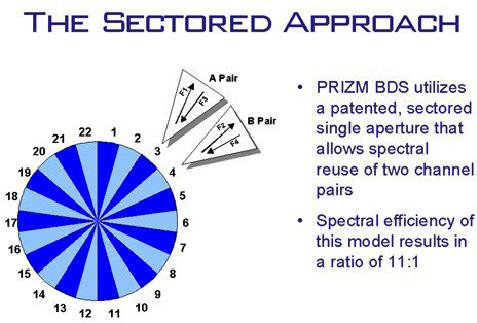
Chapter
11: Case Studies
339
2.4
GHz when we found out
about a start-up company
that was offering a
new
solution
that promised longer
distances, dramatically higher
throughput, and
the
possibility of frequency reuse
with narrowband
microwaves.
Broadband
delivery system
After
visiting the Nashua, New
Hampshire, facilities of Spike
Technologies,
we
were convinced that their
proprietary antenna and
radio system was
the
best
solution for the
requirements of our state
network, for the
following
reasons:
Their
broadband delivery system
employs a special sectored
antenna (Figure
11.9),
with 20 dBi gain on each of
up to 22 independent sectors. Each
sector
transmits
and receives on independent
channels at 10 Mbps full
duplex, for an
aggregate
throughput of 440 Mbps.
Frequency reuse on interleaved
sectors
makes
for a spectrally efficient
system.
Figure
11.9: Spike Technologies'
full duplex, high density
sectoral system.
The
narrowband digital radios
can operate anywhere from 1
to 10 GHz, with
a
coverage of up to 50 km. The
radios work with a variety
of cable TV mo-
dems,
delivering a standard 10Base-T
LAN connection to the
subscriber. At
the
base station, the sectors
are interconnected with a
high-speed switch
that
has
a very small latency (see
Figure
11.10), allowing
applications such as
streaming
video at up to 30 frames per
second. Each sector acts as
an inde-
pendent
Ethernet LAN.
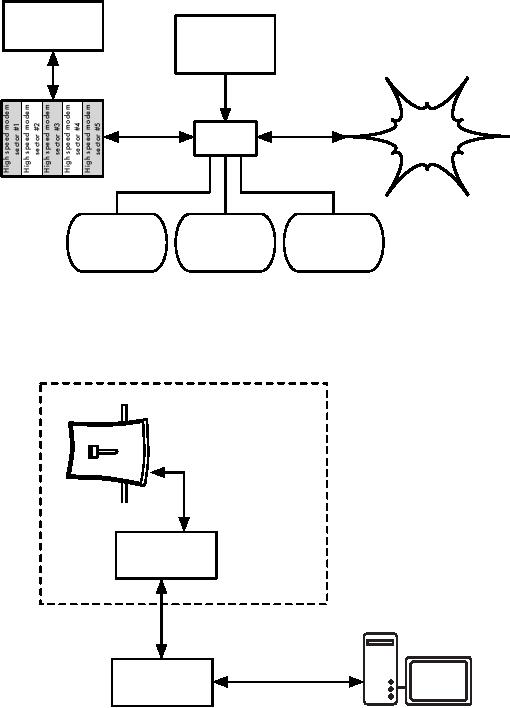
340
Chapter
11: Case Studies
Cabling
to
Network
transceivers
Management
Software
Internet
Switch
Video
Servers
File
Servers
Telephony
�
Conferencing
�
Data
Servers
�
VOD
�
Mail
�
Broadcast
�
Web
pages
Figure
11.10: Spike Technologies'
system interconnections.
At
the subscriber site, a
similar radio and modem
provide a 10BaseT
connec-
tion
to the local
Ethernet.
Outside
Equipment
RF
Cable
Transceiver
Intermediate
Frequency
Cable
PC
Modem
10baseT
connection
Figure
11.11: The subscriber end of
the link.
With
funding from Fundacite, a
trial system was soon
installed in M�rida,
with
the
base station located just
above the cable car
station of La Aguada at an
altitude
of 3600 m.
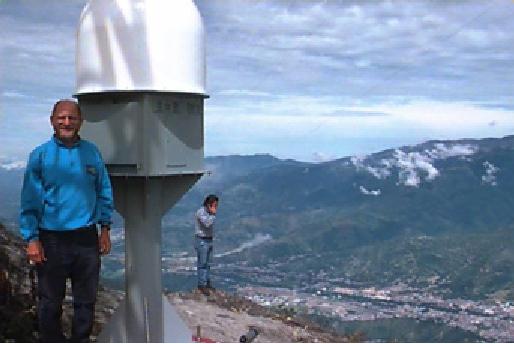
Chapter
11: Case Studies
341
Figure
11.12: Installation above
M�rida at La Aguada, at 3600
meters.
Initially
only 5 sectors were
installed, with a beamwidth of 16
degrees each.
The
first subscriber site was at
Fundacite�s premises, where a
satellite system
provides
Internet access. Sector two
served the Governor's
Palace. Sector
three
served FUNDEM, a relief
organization of the local
government. Sector
four
served a penitentiary near
the town of Lagunillas,
about 35 km from M�-
rida.
The fifth sector transmitted
to a mountaintop repeater close to
the village
of
La Trampa, 40 km from La Aguada.
From La Trampa, another 41 km
link
extended
the network to the House of
Science in the town of
Tovar.
On
January 31, 1998, a videoconference
between the penitentiary and
the Jus-
tice
Palace in M�rida proved that, aside
from Internet access, the
system could
also
support streaming video. In this
case it was used for the
arraignment of
prisoners,
thus avoiding the
inconveniences and risks of
their transportation.
The
success of the trial
prompted the state
government to allocate the
funding
for
a complete system to give
high-speed Internet access to
the state health
system,
educational system, libraries,
community centers, and
several gov-
ernmental
agencies. In January 1999 we
had 3 hospitals, 6 educational
institu-
tions,
4 research institutions, 2 newspapers, 1
TV station, 1 public library,
and
20
social and governmental
institutions sharing information
and accessing the
Internet.
Plans call for 400
sites to be connected within
this year at full
duplex
10
Mbps speed, and funding
has already been allocated
for this purpose.
Figure
11.13 shows a
map of the state of M�rida.
The dark lines show
the
initial
backbone, while the light
lines show the
extension.
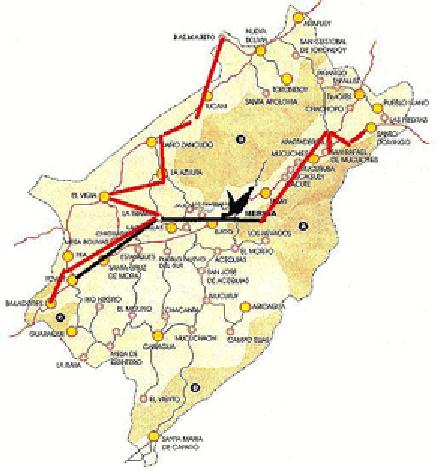
342
Chapter
11: Case Studies
Figure
11.13: The M�rida State
network
Among
the many activities
supported by the network, it is
worthwhile to men-
tion
the following:
�
Educational:
Schools have found an
endless supply of material of
the
highest
quality for pupils and
teachers, especially in the
areas of geogra-
phy,
languages, and sciences, and
as a tool to communicate with
other
groups
that share common interests.
Libraries have rooms with
computers
accessible
to the general public with
full Internet capabilities.
Newspaper
and
TV stations have an amazing
source of information to make
available
to
their audience.
�
Health:
The university hospital has
a direct link to the
intensive care unit,
where
a staff of specialist physicians is
always on duty. These
doctors are
available
to be queried by their colleagues in
remote villages to
discuss
specific
cases. A group of researchers at
the university is developing
sev-
eral
telemedicine applications based on
the network.
Chapter
11: Case Studies
343
�
Research:
The astronomic observatory of
Llano del Hato, located on
a
mountain
at 3600 m and 8 degrees off
the equator will soon be
linked, al-
lowing
astronomers from all over
the world access to the
images collected
there.
Field researchers in many
villages will enjoy Internet
access.
�
Government:
Most government agencies are
already connected and
start-
ing
to put information online
for the citizens. We expect
this to have a pro-
found
impact on the relationship of
citizens with the
government. Relief
agencies
and law enforcement agencies
make heavy use of the
network.
�
Entertainment
and Productivity: For
people living outside the
city, the
opportunities
offered by the Net have a
significant
impact on the quality
of
their
lives. We hope that this
will help to reverse the
trend of migrating
out
of
the countryside, alleviating
the overcrowding of the
urban areas. Farm-
ers
have access to information
about the commanding prices
of their crops
and
supplies, as well as improved
agricultural practices.
SUPERCOMM
'98, held in Atlanta in
June, cited the M�rida
broadband deliv-
ery
network as winner of the
SUPERQuest award in category
8-Remote Ac-
cess
as the best in that
particular field of
nominees.
Training
Since
our earliest efforts to
establish a computer network, we
realized that
training
was of paramount importance
for the people involved in
the network
construction,
management, and maintenance.
Given our very limited
budget,
we
decided that we had to pool
our resources with those of
other people who
also
required training. In 1990
the ICTP organized the
First International
School
on computer network analysis
and management, which was
attended
by
Professor Jose Silva and
Professor Luis Nunez from
our university. Upon
returning
to M�rida, they proposed
that we should somehow
emulate this
activity
in our university. To this
end, taking advantage of my
sabbatical, I
spent
three months at Bellcore in
Morristown, New Jersey, and
three more
months
at the ICTP helping in the
preparation of the Second
Networking
School
in 1992, where I was joined
by my colleague Professor Edmundo
Vi-
tale.
I spent the rest of my
sabbatical at SURANET in College
Park, Mary-
land,
under the guidance of Dr.
Glenn Ricart, who introduced
me to Dr. Saul
Hahn
of the Organization of American
States, who offered financial
support
for
a training activity in Latin
America. These experiences
allowed us to
launch
the First Latin American
Networking School (EsLaRed'92) in
M�rida,
attended
by 45 participants from 8 countries in
the region, with
instructors
from
Europe, the United States,
and Latin America. This
hands-on training
lasted
three weeks, and wireless
technologies were
emphasized.
EsLaRed'95
gathered again in M�rida
with 110 participants and 20
instruc-
tors.
EsLaRed'97 had 120
participants, and it was
endorsed by the
Internet
Society,
which also sponsored a
Spanish and Portuguese first
Networking
344
Chapter
11: Case Studies
Workshop
for Latin America and
the Caribbean, held in Rio
de Janeiro in 1998
with
EsLaRed responsible for the
training content. Now ten
years later, Es-
LaRed
continues to expand its
training efforts throughout South
America.
Concluding
remarks
The
Internet has an even more
profound impact in developing
countries
than
elsewhere, owing to the high
cost of international phone
calls, faxes,
magazines,
and books. This is obviously
exacerbated by the lower
average
income
of people. Some dwellers in
remote villages that do not
have tele-
phones
are experiencing a transition
from the 19th to the
21st century
thanks
to wireless networking. It is hoped
that this will contribute to
the im-
provement
of lifestyles in the fields of
health, education, entertainment,
and
productivity,
as well as create a more
equitable relationship between
citi-
zens
and government.
References
�
Karn, Phil, "The KA9Q
Internet (TCP/IP) Package: A
Progress Report,"
Sixth
ARRL Computer Networking
Conference, Redondo Beach,
CA, 29
August
1987.
�
Heatherington, D., "A 56 kilobaud RF
modem," Sixth ARRL Computer
Net-
working
Conference, Redondo Beach,
CA, 29 August 1987.
�
Conatel, Comision Nacional de
Comunicaciones, Ministerio de
Transporte
y
Comunicaciones, "NORMAS PARA LA
OPERACION DE SISTEMAS DE
TELECOMUNICACIONES
CON TECNOLOGIA DE BANDA
ESPARCIDA
(SPREAD
SPECTRUM)," Caracas, 17 November
1993.
�
International Centre For
Theoretical Physics, "Programme of
Training and
System
Development on Networking and
Radiocommunications," Trieste,
Italy,
1996, http://www.ictp.trieste.it/
�
Escuela Latinoamericana de Redes,
http://www.eslared.org.ve/
--Ermanno
Pietrosemoli
Chapter
11: Case Studies
345
Case
study: Chilesincables.org
Recent
wireless data transmission
technologies allow the
creation of high
speed,
geographically separated networks at a
relatively low cost. If
these
networks
are built around the
idea of removing restrictions to
data access,
we
call them free
networks. Such
networks can bring great
benefits to
every
user,
independent of the their
political, economic, or social
conditions. This
kind
of network is a direct response to
the often restrictive
commercial model
ruling
over much of our modern
western society.
In
order for free networks to
flourish,
wireless technologies must be
adapted
and
put to the best possible
use. This is carried out by
groups of hackers
who
do the research, investigation,
development and implementation of
pro-
jects,
as well as permit free
access to the knowledge
gained.
Chilesincables.org
endeavors
to promote and organize
wireless free net-
works
in Chile in a professional way. We do
this by providing
education
about
the related legal and
technical aspects of wireless
networking; en-
couraging
the adaptation of new
technologies through adequate
research;
and
stimulating the adaptation of
these technologies to meet
the specific
needs
of Chilean communities and
society.
Description
of technology
We
employ a variety of wireless
technologies, including IEEE
802.11a/b/g.
We
are also investigating
recent innovations in the field,
such as WiMAX. In
most
cases, the equipment has
been modified in order to
be accept external
locally
built antennas which meet
local telecommunications
regulations.
Even
though a majority of wireless
hardware available on the
market will suit
our
goals, we encourage utilization
and exploration of a few
vendors that al-
low
for better control and
adaptation to our needs
(without necessarily
in-
creasing
the prices). These include
Wi-Fi cards with chipsets
offered by Athe-
ros,
Prism, Orinoco, and Ralink,
as well as some models of
access points
manufactured
by Linksys, Netgear, and
Motorola. The hacker
community has
developed
firmware
that provides new
functionality on this
equipment.
For
the network backbone itself,
we employ Open Source
operating systems,
including
GNU/Linux, FreeBSD, OpenBSD,
and Minix. This fits our
needs in
the
areas of routing as well as
implementation of services such as
proxies,
web
and FTP servers, etc. In
addition, they share our
project s
philosophy
of
being
free technology with open
source code.
346
Chapter
11: Case Studies
Uses
and applications
The
networks implemented so far
allow the following
tasks:
�
Transfer of data via FTP or
web servers
�
VoIP services
�
Audio and video
streaming
�
Instant messaging
�
Exploration and implementation of
new services such as LDAP,
name reso-
lution,
new security methods,
etc.
�
Services provided by the
clients. The users are
free to use the net
s infra-
structure
in order to create their own
services.
Administration
and maintenance
The
operational unit of the
network is the node. Each
node allows clients
to
associate
to the network and obtain
basic network services. In
addition,
each
node must be associated to at
least another node, by
convention.
This
allows the network to grow
and to make more services
available to
every
client.
A
node is maintained by an administrator
who is a member of the
community
committed
to the following
tasks:
�
Maintenance of an adequate uptime
(over 90%).
�
Providing basic services
(typically web
access).
�
Keeping the clients updated
about the node s
services
(for example, how to
get
access to the network). This
is generally provided by a captive
portal.
The
general administration of the
network (specifically,
tasks related to de-
ployment
of new nodes, selection of
sites, network s
topology,
etc.) is carried
out
by the board of the
community, or by technicians trained
for this purpose.
Chilesincables.org
is currently in the process of
acquiring legal
organization
status,
a step that will allow
the regulation of its
internal administrative
proce-
dures
and the formalization of the
community in our
society.
Chapter
11: Case Studies
347
Training
and capacity building
Chilesincables.org
considers training of its
members and clients to be of
vital
importance
for the following
reasons:
�
The radio spectrum must be
kept as clear as possible in
order to guarantee
adequate
quality of wireless connections.
Therefore, training in radio
com-
munications
techniques is essential.
�
The employment of materials
and methods approved by the
current regula-
tions
is a requirement for the
normal development of the
activities.
�
In order to comply with
Internet standards, all of
our network
administrators
are
trained in TCP/IP
networking.
�
To ensure continuity in network
operations, knowledge of networking
tech-
nology
must be transferred to the
users.
To
support these principles,
Chilesincables.org undertakes the
following
activities:
�
Antenna
Workshop. Attendees
are trained in the
construction of anten-
nas,
and introduced to basic
concepts of radio
communication.
�
Operating
Systems Workshop. Training on
the implementation of
routers
and
other devices based on
GNU/Linux or other software
such as
m0n0wall
or pfsense. Basic networking
concepts are also
taught.
�
Promotion
and Advertising. Events
for different communities
that pursue
our
same goals are promoted.
These include college
workshops, lectures,
free
software gatherings,
etc.
�
Updating
of Materials. Chilesincables.org
maintains a number of
free-
access
documents and materials made
available to people interested in
a
specific
activity.
The
pictures on the following
pages present a brief
account of the activities
in
our
community.
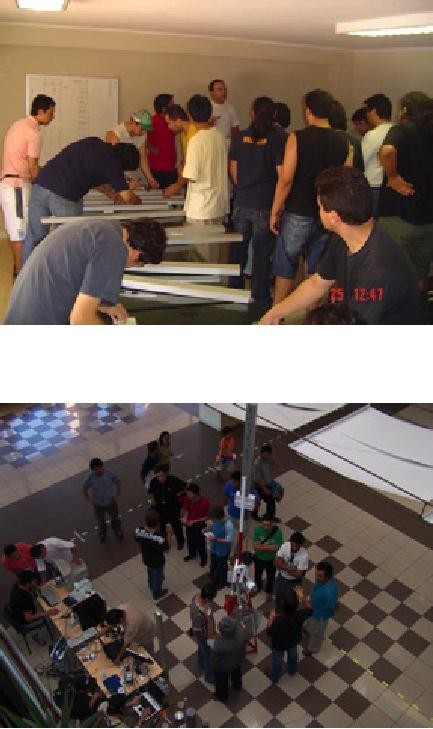
348
Chapter
11: Case Studies
Figure
11.14: Omnidirectional slotted
antenna workshop. In this
session, attendants
learned
about building antennas and
related theory.
Figure
11.15: One of our staff
members lecturing on the
implementation of a
m0nowall-based
router in the administration of a
node.
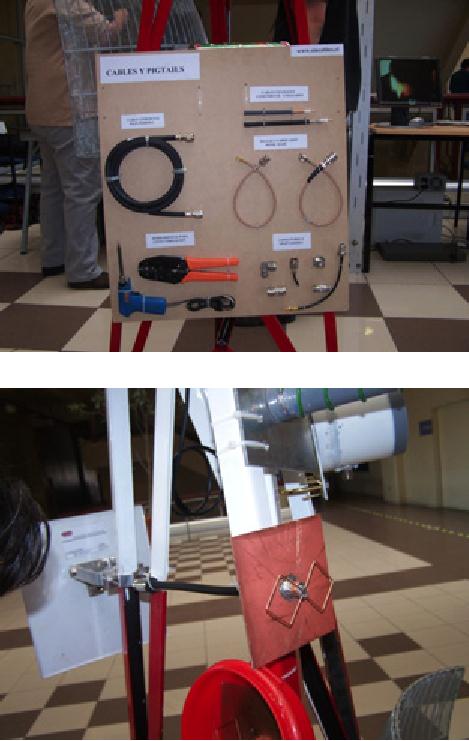
Chapter
11: Case Studies
349
Figure
11.16: Detail of mini tower
with samples of antennas,
cables and
pigtails.
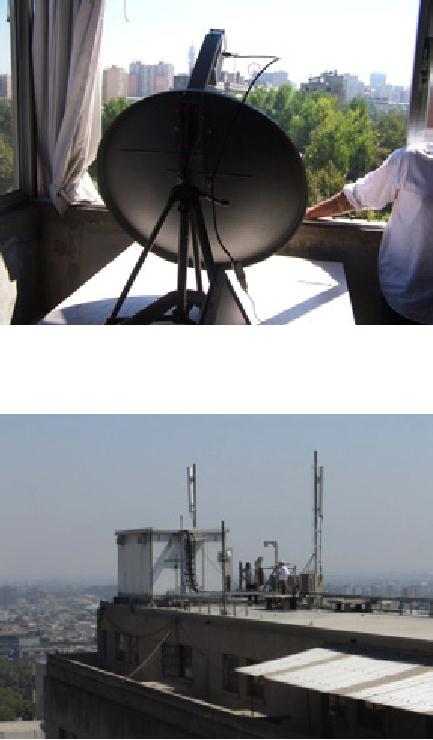
350
Chapter
11: Case Studies
Figure
11.17: Wireless station and
parabolic antenna used for
the transmission of
Santiago-2006
FLISOL via streaming
video.
Figure
11.18: Location of the other
end of the link.
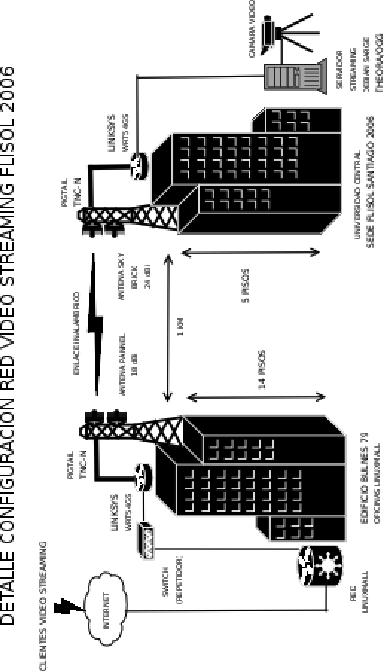
Chapter
11: Case Studies
351
Figure
11.19: Schematic representing
Santiago-2006 FLISOL video
streaming
transmission,
using free software. The
wireless transmission speed
achieved was
36
Mbps at 1 km.
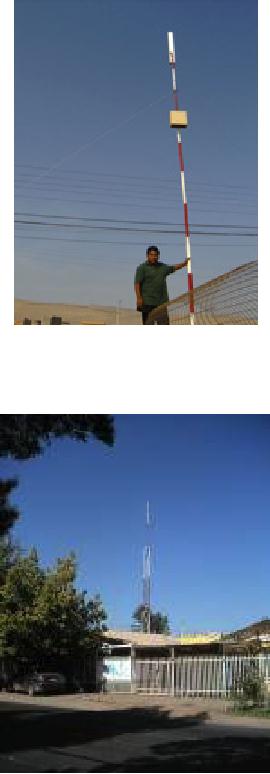
352
Chapter
11: Case Studies
Figure
11.20: Quiani node. This is
one of the world's highest
nodes. Its located at
an
elevation
of 4000 m, about 2000 km
north of the country's
capital.
Figure
11.21: Node in southern
Santiago, consisting of a 15 m tower, a
Trevor
Marshall
16+16 antenna, and 30
clients. The node is
connected to a downtown
node
more
than 12 km away.
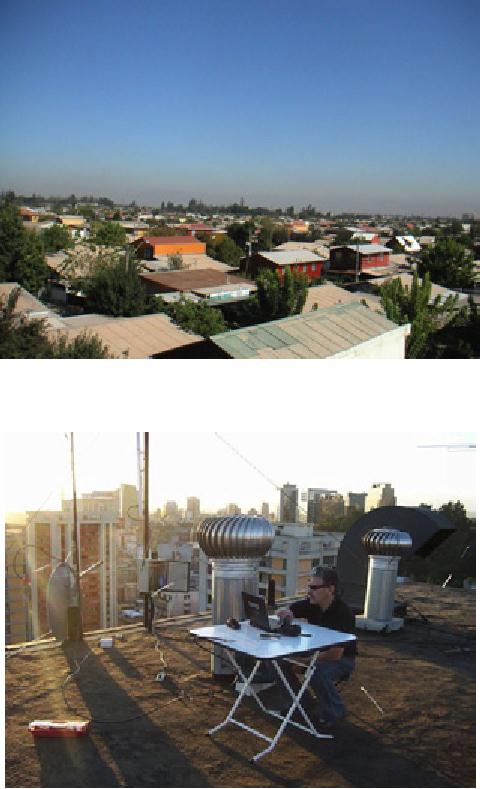
Chapter
11: Case Studies
353
Figure
11.22: Panoramic view of a
node from the top of
the tower.
Figure
11.23: Downtown node
connected to the Santiago
southern node. Note
the
parabolic
antenna for backhaul and
the slotted antenna to
connect the
clients.
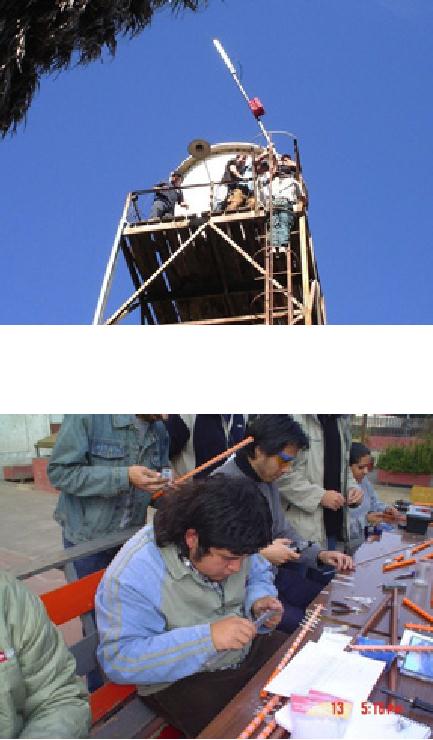
354
Chapter
11: Case Studies
Figure
11.24: Implementation of node
over a water tower in
Batuco, Metropolitan
Region,
providing backhaul to Cabrati
telecenter.
Figure
11.25: Workshop on Yagi
antennas organized by our
community. Participants
are
building their own
antennas.
Chapter
11: Case Studies
355
Credits
Our
community is made up of a group of
committed volunteer
associates
among
which are worthy of
notice:
Felipe
Cortez (Pulpo), Felipe
Benavides (Colcad), Mario
Wagenknecht
(Kaneda),
Daniel Ortiz (Zaterio),
Cesar Urquejo (Xeuron),
Oscar Vasquez
(Machine),
Jose San Martin (Packet),
Carlos Campano (Campano),
Christian
Vasquez
(Crossfading), Andres Peralta
(Cantenario), Ariel Orellana
(Ariel),
Miguel
Bizama (Picunche), Eric Azua
(Mr. Floppy), David Paco
(Dpaco),
Marcelo
Jara (Alaska).
--Chilesincables.org
Case
study: Long Distance 802.11
Thanks
to a favorable topography, Venezuela
already has some long
range
WLAN
links, like the 70 km long
operated by Fundacite M�rida
between Pico
Espejo
and Canagua.
To
test the limits of this
technology, it is necessary to find a
path with an unob-
structed
line of sight and a
clearance of at least 60% of
the first Fresnel
zone.
While
looking at the terrain in
Venezuela, in search of a stretch
with high ele-
vation
at the ends and low
ground in between, I first
focused in the
Guayana
region.
Although plenty of high
grounds are to be found, in
particular the fa-
mous
"tepuys" (tall mesas with
steep walls), there were
always obstacles in
the
middle ground.
My
attention shifted to the
Andes, whose steep slopes
(rising abruptly from
the
plains) proved adequate to
the task. For several
years, I have been
trav-
eling
through sparsely populated
areas due to my passion for
mountain bik-
ing.
In the back of my head, I
kept a record of the
suitability of different
spots
for
long distance
communications.
Pico
del Aguila is a very
favorable place. It has an
altitude of 4200 m and
is
about
a two hour drive from my
home town of M�rida. For
the other end, I
finally
located the town of El Ba�l,
in Cojedes State. Using the
free software
Radio
Mobile (available at http://www.cplus.org/rmw/english1.html), I
found
that
there was no obstruction of
the first
Fresnel zone (spanning 280
km)
between
Pico del Aguila and El
Ba�l.
356
Chapter
11: Case Studies
Action
Plan
Once
satisfied with
the existence of a suitable
trajectory, we looked at
the
equipment
needed to achieve the goal.
We have been using Orinoco
cards
for
a number of years. Sporting an
output power of 15 dBm and
receive
threshold
of -84 dBm, they are
robust and trustworthy. The
free space loss at
282
km is 149 dB. So, we would
need 30 dBi antennas at both
ends and
even
that would leave very
little margin for other
losses.
On
the other hand, the
popular Linksys WRT54G
wireless router runs
Linux.
The Open Source community
has written several firmware
versions
for
it that allow for a complete
customization of every transmission
parame-
ter.
In particular, OpenWRT firmware
allows for the adjustment of
the ac-
knowledgment
time of the MAC layer, as
well as the output power.
Another
firmware,
DD-WRT, has a GUI interface
and a very convenient site
survey
utility.
Furthermore, the Linksys can
be located closer to the
antenna than a
laptop.
So, we decided to go with a
pair of these boxes. One
was config-
ured
as an AP (access point) and
the other as a client. The
WRT54G can
operate
at 100 mW output power with
good linearity, and can
even be
pushed
up to 200 mW. But at this
value, non linearity is very
severe and
spurious
signals are generated, which
should be avoided. Although
this is
consumer
grade equipment and quite
inexpensive, after years of
using it,
we
felt confident that it could
serve our purpose. Of
course, we kept a
spare
set handy just in
case.
By
setting the output power to
100 mW (20 dBm), we could
obtain a 5dB
advantage
compared with the Orinoco
card. Therefore, we settled
for a pair
of
WRT54Gs.
Pico
del �guila site
survey
On
January 15, 2006, I went to
Pico �guila to check out
the site that
Radio
Mobile
had reported as suitable.
The azimuth towards El Ba�l
is 86�, but
since
the magnetic declination is 8� 16
, our
antenna should be pointed to
a
magnetic
bearing of 94�.
Unfortunately,
when I looked towards 94�, I
found the line of sight
obstructed
by
an obstacle that had not
been shown by the software,
due to the limited
resolution
of the digital elevation
maps that are freely
available.
I
rode my mountain bike for
several hours examining the
surrounding area
looking
for a clear path towards
the East. Several promising
spots were iden-
tified,
and for each of them I
took photos and recorded
the coordinates with
a
GPS
for later processing with
the Radio Mobile software.
This led me to re-
fine my path
selection, resulting in the
one depicted in Figure
11.26 using
Google
Earth:
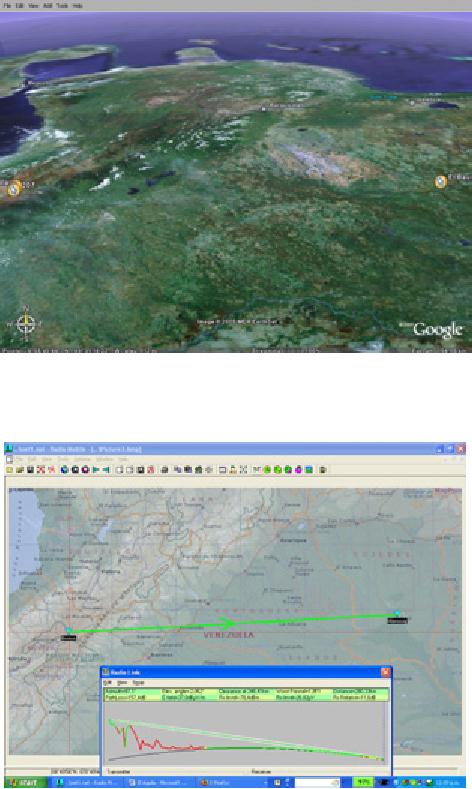
Chapter
11: Case Studies
357
Figure
11.26: View of the 280 km
link. Maracaibo's Lake is to the
West, and the
Peninsula
of Paraguan� is to the
North.
The
radio profile obtained
with Radio Mobile is shown
in Figure
11.27:
Figure
11.27: Map and
profile of
the proposed path between
Pico Aguila, and
Morrocoy
hill, near the town of El
Ba�l.
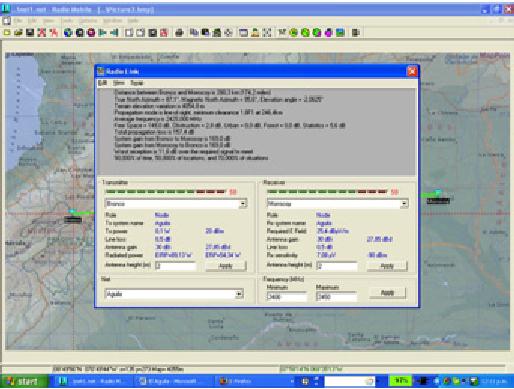
358
Chapter
11: Case Studies
The
details of the wireless link
are displayed in Figure
11.28:
Figure
11.28: Propagation details of
the 280 km link.
In
order to achieve a reasonable
margin of some 12 dB for the
link, we
needed
antennas with at least 30
dBi gain at each
end.
Antennas
High
gain antennas for the
2.4 GHz band are
not available in Venezuela.
The
importation
costs are considerable, so we
decided instead to recycle
para-
bolic
reflectors
(formerly used for satellite
service) and replaced the
feed with
one
designed for 2.4 GHz. We
proved the concept with an
80 cm dish. The
gain
was way too low, so we
tried an offset fed 2.4 m
reflector.
This offered
ample
gain, albeit with some
difficulties in
the aiming of the 3.5�
beam. The
22.5�
offset meant that the
dish appeared to be pointing
downwards when it
was
horizontally aligned.
Several
tests were performed using
various cantennas and a 12
dBi Yagi as a
feed.
We pointed the antenna at a
base station of the
university wireless net-
work
that was located 11 km away
on a 3500 m mountain. The
test site sits at
2000
m and therefore the
elevation angle is 8�.
Because of the offset feed,
we
pointed
the dish 14� downward, as
can be seen in the following
picture:
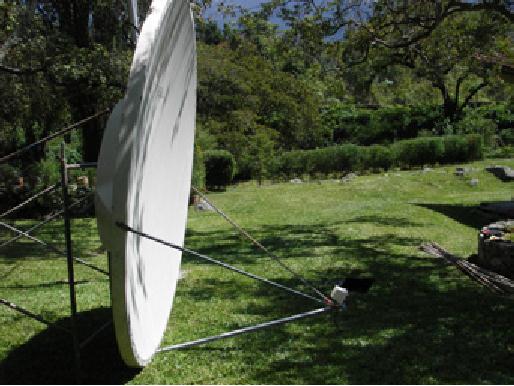
Chapter
11: Case Studies
359
Figure
11.29: 2.4 m offset fed
reflector
with a 12 dBi antenna at its
focus, looking
14� down.
The actual elevation is 8� up.
We
were able to establish a
link with the base
station at Aguada, but our
efforts
to
measure the gain of the
setup using Netstumbler were
not successful. There
was
too much fluctuation on the
received power values of
live traffic.
For
a meaningful measurement of the
gain, we needed a signal
generator
and
spectrum analyzer. These
instruments were also
required for the field
trip
in order to align the
antennas properly.
While
waiting for the required equipment, we
looked for an antenna to be used
at
the
other end, and also a pointing
system better suited to the
narrow radio beam.
In
February 2006, I traveled to
Trieste to partake in the
annual wireless
train-
ing
event that I have been
attending since 1996. While
there, I mentioned
the
project
to my colleague Carlo Fonda,
who was immediately thrilled
and eager
to
participate.
The
collaboration between the
Latin
American Networking School
(Es-
LaRed) and
the Abdus
Salam International Centre
for Theoretical
Phys-
ics
(ICTP) goes
back to 1992, when the
first
Networking School was held
in
M�rida
with ICTP support. Since
then, members of both
institutions have
col-
laborated
in several activities. Some of
these include an annual
training
school
on wireless networking (organized by
ICTP) and another on
computer
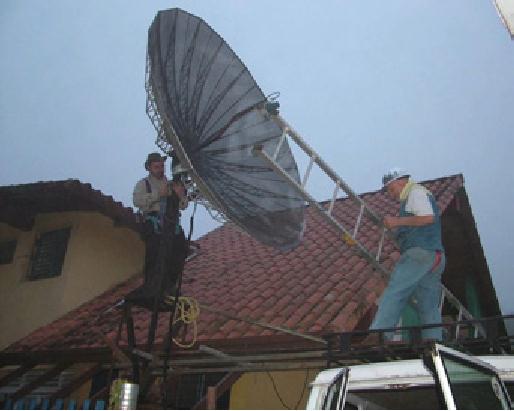
360
Chapter
11: Case Studies
networks
(organized by EsLaRed) that
are hosted in several
countries
throughout
Latin America. Accordingly, it
was not difficult to
persuade Dr.
Sandro
Radicella, the head of the
Aeronomy and Radio
Propagation Labora-
tory
at ICTP, to support Carlo
Fonda s
trip in
early April to Venezuela in
order
to
participate in the
experiment.
Back
at home, I found a 2.75 m
parabolic central fed mesh
antenna at a
neighbors
house. Mr. Ismael Santos
graciously lent his antenna
for the ex-
periment.
Figure
11.30 shows
the disassembly of the mesh
reflector.
Figure
11.30: Carlo and Ermanno
disassembling the satellite
dish supplied by
Mr.
Ismael Santos.
We
exchanged the feed for a
2.4 GHz one, and
aimed the antenna at a
sig-
nal
generator that was located
on top of a ladder some 30 m
away. With a
spectrum
analyzer, we measured the
maximum of the signal and
located the
focus.
We also pinpointed the
boresight for both the
central fed and the
offset
antennas.
This is shown in Figure
11.31:
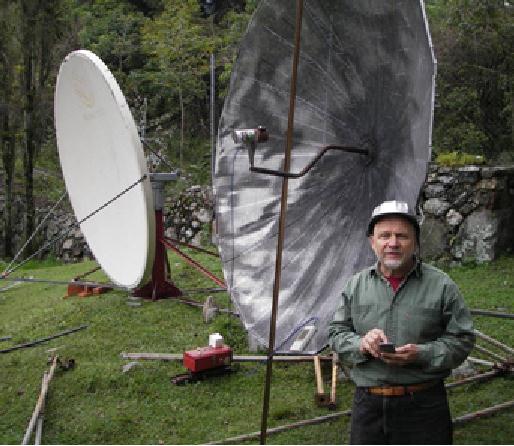
Chapter
11: Case Studies
361
Figure
11.31: Finding the focus of
the antennas with the
2.4 GHz feed
We
also compared the power of
the received signal with
the output of a
commercial
24 dBi antenna. This showed
a difference of 8 dB, which
led us
to
believe that the overall
gain of our antenna was
about 32 dBi. Of
course,
there
is some uncertainty about
this value. We were
receiving reflected
sig-
nals,
but the value agreed
with the calculation from
the antenna
dimension.
El
Ba�l Site Survey
Once
we were satisfied with the
proper functioning and aim
of both anten-
nas,
we decided to do a site survey at
the other end of the El
Ba�l link.
Carlo
Fonda, Gaya Fior and
Ermanno Pietrosemoli reached
the site on
April
8th. The following day, we
found a hill (south of the
town) with two
telecom
towers from two cell
phone operators and one
belonging to the
mayor
of El Ba�l. The hill of
Morrocoy is some 75 m above
the surrounding
area,
about 125 m above sea
level. It provides an unobstructed
view to-
wards
El Aguila. There is a dirt
road to the top, a must
for our purpose,
given
the weight of the
antenna.
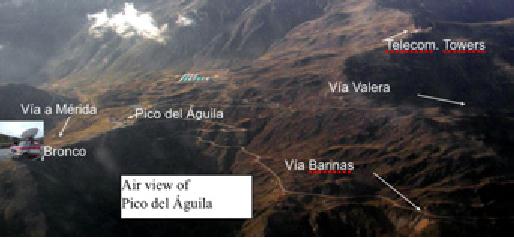
362
Chapter
11: Case Studies
Performing
the experiment
On
Wednesday April 12th, Javier
Trivi�o and Ermanno
Pietrosemoli traveled
towards
Ba�l with the offset
antenna loaded on top of a
four-wheel drive
truck.
Early the morning of April
13th, we installed the
antenna and pointed
it
at
a compass bearing of 276�,
given that the declination
is 8� and therefore
the
true Azimuth is 268�.
At
the same time, the
other team (composed by
Carlo Fonda and Gaya
Fior
from
ICTP, with assistance of
Franco Bellarosa, Lourdes
Pietrosemoli and
Jos�
Trivi�o) rode to the
previously surveyed area at
Pico del Aguila in a
Bronco
truck that carried the
2.7 m mesh antenna.
Figure
11.32: Pico del �guila
and surrounds map with
Bronco truck.
Poor
weather is common at altitudes of 4100 m above
sea level. The Aguila team
was
able to install and point the mesh antenna before the
fog and sleet began.
Figure
11.33 shows
the antenna and the rope used for aiming the 3�
radio beam.
Power
for the signal generator
was supplied from the
truck by means of a 12
VDC
to 120 VAC inverter. At 11
A.M in El Ba�l, we were able
to observe a
-82
dBm signal at the agreed
upon 2450 MHz frequency
using the spectrum
analyzer.
To be sure we had found the
proper source, we asked
Carlo to
switch
off the signal. Indeed,
the trace on the spectrum
analyzer showed only
noise.
This confirmed
that we were really seeing
the signal that
originated
some
280 km away.
After
turning the signal generator
on again, we performed a fine tuning
in
elevation
and azimuth at both ends.
Once we were satisfied that we
had at-
tained
the maximum received signal,
Carlo removed the signal
generator and
replaced
it with a Linksys WRT54G
wireless router configured as an
access
point.
Javier substituted the
spectrum analyzer on our end
for another
WRT54G
configured as a
client.
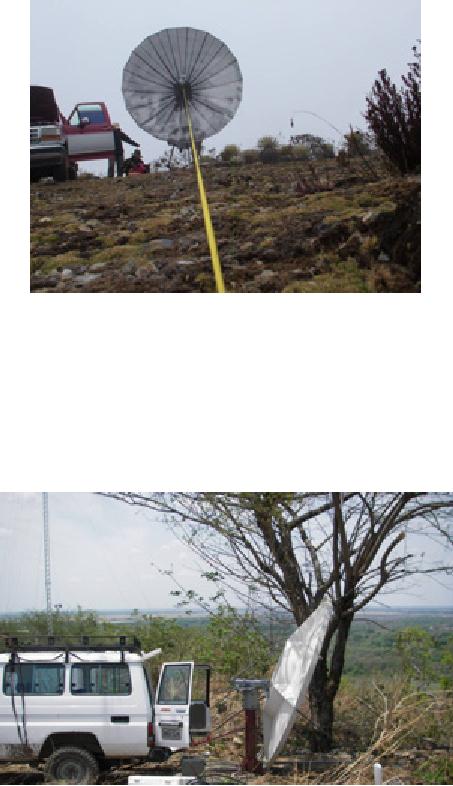
Chapter
11: Case Studies
363
Figure
11.33: Aiming the antenna at
el �guila.
At
once, we started receiving
"beacons" but ping packets
did not get
through.
This
was expected, since the propagation time
of the radio wave over a 300 km
link
is 1 ms. It takes at least 2 ms for an
acknowledgment to reach the transmitter.
Fortunately,
the OpenWRT firmware allows for
adjusting the ACK timing.
After Carlo
adjusted
for the 3 orders of magnitude
increase in delay above what
the standard
Wi-Fi
link expects, we began
receiving packets with a
delay of about 5 ms.
Figure
11.34: El Ba�l antenna
installation. Actual elevation
was 1� upward,
since the
antenna
has an offset of
22.5�.
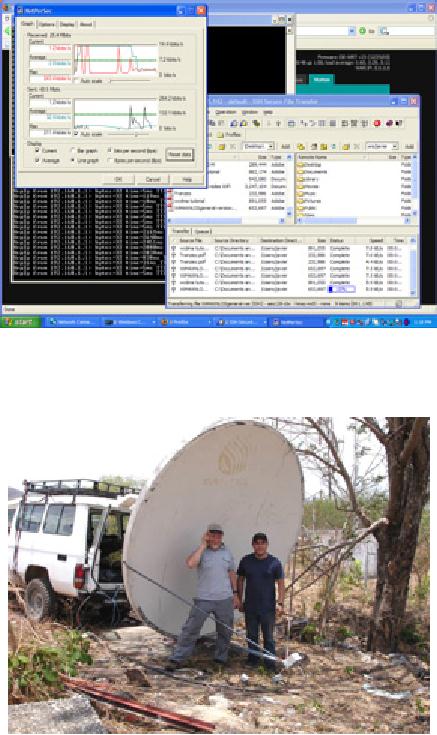
364
Chapter
11: Case Studies
We
proceeded to transfer several
PDF files
between Carlo s
and
Javier s
laptops.
The results are shown in
Figure
11.35.
Figure
11.35: Screenshot of Javier's
laptop showing details of
PDF file
transfer from
Carlo's
laptop 280 km away, using
two WRT54G wireless routers, no
amplifiers.
Note
the ping time of a few
milliseconds.
Figure
11.36: Javier Trivi�o
(right) and Ermanno
Pietrosemoli beaming from
the
El
Ba�l antenna
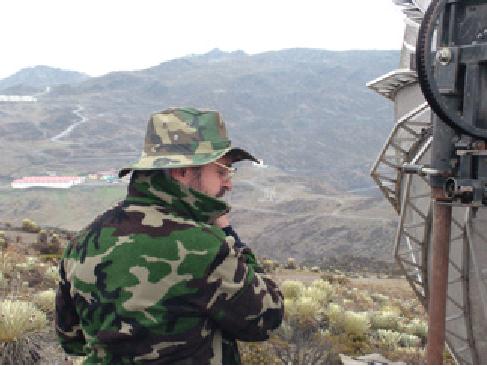
Chapter
11: Case Studies
365
Figure
11.37: Carlo Fonda at the
Aguila Site
M�rida,
Venezuela, 17 April 2006.
One
year after performing this
experiment, we found the
time and resources
to
repeat it. We used
commercial 30 dBi antennas,
and also a couple of
wire-
less
routers which had been
modified by the
TIER group led by Dr.
Eric
Brewer
of Berkeley University.
The
purpose of the modification of
the standard WiFi MAC is to
make it suit-
able
for long distance
applications by replacing the
CSMA Media Access
Control
with TDMA. The latter is
better suited for long
distance point-to-point
links
since it does not require
the reception of ACKs. This
eliminates the
need
to wait for the 2 ms round
trip propagation time on a
300 km path.
On
April 28th, 2007, a team
formed by Javier Trivi�o,
Jos� Torres and
Fran-
cisco
Torres installed one of the
antennas at El Aguila site.
The other team,
formed
by Leonardo Gonz�lez V.,
Leonardo Gonz�lez G.,
Alejandro
Gonz�lez
and Ermanno Pietrosemoli,
installed the other antenna
at El Ba�l.
A
solid link was quickly
established using the
Linksys WRT54G
routers.
This
allowed for video
transmission at a measured throughput of
65 kbps.
With
the TDMA routers, the
measured throughput was 3
Mbps in each di-
rection.
This produced the total of 6
Mbps as predicted by the
simulations
done
at Berkeley.
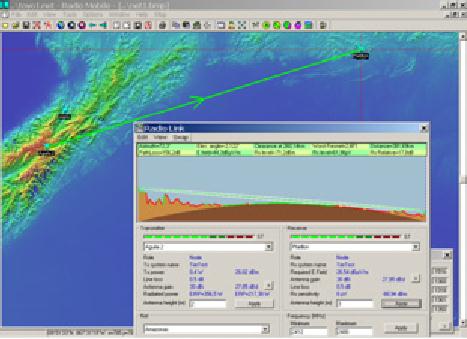
366
Chapter
11: Case Studies
Can
we do better?
Thrilled
by these results, which pave
the way for really
inexpensive long dis-
tance
broadband links, the second
team moved to another
location previ-
ously
identified at 382 km
from El Aguila, in a place
called Platill�n.
Platill�n
is
1500 m above sea level
and there is an unobstructed first
Fresnel zone
towards
El Aguila (located at 4200 m
above sea level). The
proposed path is
shown
in Figure
11.38:
Figure
11.38: Map and
profile of
the 380 km path.
Again,
the link was quickly
established with the Linksys
and the TIER
sup-
plied
routers. The Linksys link
showed approximately 1% packet
loss, with an
average
round trip time of 12 ms.
The TIER equipment showed no
packet
loss,
with propagation times below
1 ms. This allowed for
video transmission,
but
the link was not
stable. We noticed considerable
signal fluctuations
that
often
interrupted the
communication.
However,
when the received signal
was about -78 dBm,
the measured
throughput
was a total of 6 Mbps
bidirectional with the TIER
routers imple-
menting
TDMA.
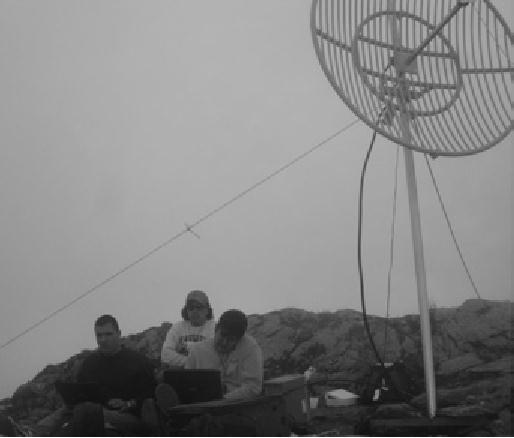
Chapter
11: Case Studies
367
Figure
11.39: The team at el
Aguila, Jos� Torres (left),
Javier Trivi�o (center) and
Fran-
cisco
Torres (right)
Although
further tests must be
conducted to ascertain the
limits for stable
throughput,
we are confident
that Wi-Fi has a great
potential for long
distance
broadband
communication. It is particularly well
suited for rural areas
were
the
spectrum is still not
crowded and interference is
not a problem,
provided
there
is good radio line of
sight.
Acknowledgments
We
wish to express our
gratitude to Mr. Ismael
Santos for lending the
mesh
antenna
to be installed at El Aguila and to
Eng. Andr�s Pietrosemoli for
sup-
plying
the special scaffolding
joints used for the
installation and
transporta-
tion
of the antennas.
We'd
also like to thank the
Abdus Salam International
Centre of Theoretical
Physics
for supporting Carlo Fonda
s trip
from Italy to
Venezuela.
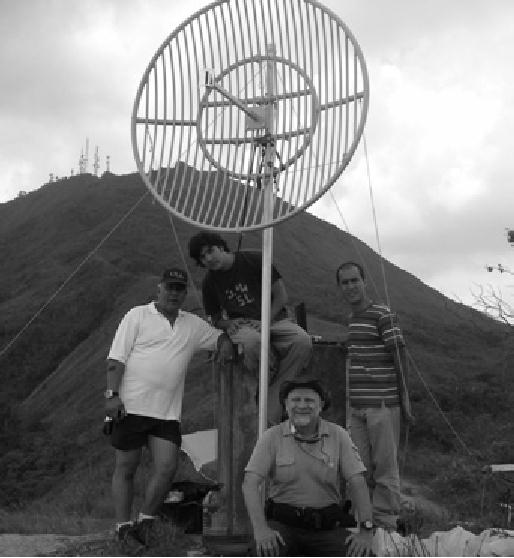
368
Chapter
11: Case Studies
Figure
11.40: The team at
Platillon. From left to
right: Leonardo Gonz�lez
V.,
Leonardo
Gonz�lez G., Ermanno
Pietrosemoli and Alejandro
Gonz�lez .
The
2006 experiment was
performed by Ermanno Pietrosemoli,
Javier
Trivi�o
from EsLaRed, Carlo Fonda,
and Gaya Fior from
ICTP. With the
help
of
Franco Bellarosa, Lourdes
Pietrosemoli, and Jos�
Trivi�o.
For
the 2007 experiments, Dr.
Eric Brewer from Berkeley
University provided
the
wireless routers with the
modified MAC
for long distance, as well
as en-
thusiastic
support through his
collaborator, Sonesh Surana.
RedULA, CPTM,
Direcci�n
de Servicios ULA Universidad de
los Andes and Fundacite
M�rida
contributed
to this trial.
This
work was funded by
ICA-IDRC.
Chapter
11: Case Studies
369
References
�
Fundaci�n Escuela Latinoamericana de
Redes, Latin American
Networking
School,
http://www.eslared.org.ve/
�
Abdus Salam International
Centre for Theoretical
Physics,
http://wireless.ictp.it/
�
OpenWRT Open Source firmware
for Linksys, http://openwrt.org/
�
Fundacite M�rida, http://www.funmrd.gov.ve/
--Ermanno
Pietrosemoli
Table of Contents:
- Where to Begin:Purpose of this book, Fitting wireless into your existing network, Wireless networking protocols
- A Practical Introduction to Radio Physics:What is a wave?, Polarization
- Network Design:Designing the physical network, Mesh networking with OLSR, Estimating capacity
- Antennas & Transmission Lines:Cables, Waveguides, Connectors and adapters, Amplifiers
- Networking Hardware:Wired wireless, Choosing wireless components, Building an access point from a PC
- Security & Monitoring:Physical security, Threats to the network, Authentication
- Solar Power:Solar energy, Photovoltaic system components, The battery
- Building an Outdoor Node:Waterproof enclosures, Providing power, Mounting considerations
- Troubleshooting:Building your team, Proper troubleshooting technique, Common network problems
- Economic Sustainability:Create a Mission Statement, Evaluate the Demand for Potential Offerings
- Case Studies:General advice, Crossing the divide with a simple bridge in Timbuktu, Networking Mérida State
- Appendix A: Resources:Antennas and antenna design, Security
- Appendix B: Channel Allocations
- Appendix C: Path Loss
- Appendix D: Cable Sizes
- Appendix E: Solar Dimensioning:General Data, Component Characteristics
- Glossary